Perspectives of Additive Manufacturing in 5.0 Industry
Abstract
1. Introduction
- Both Industry 4.0 and Industry 5.0 use the most advanced technologies that ensure connection and communication between machines and systems, which increases process efficiency;
- Both Industry 4.0 and Industry 5.0 use the connection of industrial systems and processes in which digitalization plays a key role;
- Production personalization is an inherent feature of Industry 4.0 and 5.0. Industry 4.0 uses flexible and modular systems. Industry 5.0 is characterized by a higher level of personalization by developing flexible and efficient production, involving the cooperation of people and robots, resulting in products tailored to individual customer needs.
2. Definition and Mechanism of 3D Printing Process
3. Three-Dimensional Process Classification
- Vat Photopolymerization (VP);
- Material Jetting (MJ);
- Binder Jetting (BJT);
- Materials Extrusion (FDM);
- Powder Bed Fusion (PBF);
- Laminating Sheets;
- Directed Energy Deposition (DED).
4. Three-Dimensional Printing Technology in Industry
- Aerospace Industry: This industry in China is investing heavily in the R&D of 3D printing technologies, which is driving demand for additive manufacturing.
- Automotive Industry: The utilization of 3D-printed metals in the automotive industry is influencing demand for the global 3D printing metal market.
- Pharmaceutical Industry: The pharmaceutical industry is using these printing techniques to manufacture personalized drugs and medical devices.
- Tooling Industry: The industrial sector’s demand for 3D printing tools and tooling is contributing to the growing demand for the global market.
- Construction Industry: While still a relatively small segment, the construction industry is beginning to adopt 3D printing as a way to create cement structures at lower costs.
- The printing speed determines whether 3D production technology can be used to complement traditional production processes. The speed of 3D printing has been considered a barrier to industrial application.
- Dimensional accuracy is the basic indicator for measuring the quality of a manufactured product, regardless of the production method used.
- Labor intensity is a parameter that determines the choice of technology if there are alternative production possibilities.
- The range of materials that can be used limits production possibilities.
- Production costs.
5. Environmental Aspects of Using 3D Printing Technology
6. Prospects for the Development of 3D Printing Technology
- —
- Artificial Intelligence;
- —
- Robotics and Industrial Robots 5.0;
- —
- 3D Printing;
- —
- Internet of Things (IoT);
- —
- Learning;
- —
- Data Analysis (thanks to WMS systems);
- —
- Cybersecurity.
- Revolutionizing supply chains by offering on-demand production of custom parts and components.
- Offering local printing, and minimizing lead time and transport costs, which results in shorter supply chains, greater stability, and risk resistance.
- Eliminating the need for large, static inventories.
- Adapting products to individual customer needs
- Minimizing waste
- Optimizing material consumption through the production of additives.
- Reducing the price of parts through increased printing speeds, although the costs of 3D machines are high.
- Leading digital transformation in the era of Industry 5.0.
7. Summary
8. Conclusions
- Three-dimensional printing technology is an integral part of Industry 4.0 and 5.0. In particular, it meets the assumptions of Industry 5.0 due to cooperation with a human who designs individual solutions using advanced software and artificial intelligence.
- Three-dimensional printing shortens supply chains, saves materials, and solves the problem of obtaining parts without excessive storage. Shortening supply chains and the possibility of using recycled materials are beneficial aspects of 3D printing technology due to material shortages resulting from geopolitical conditions.
- The adaptation of 3D printing in a closed-loop economy will require the systemic development of recycling rules and the analysis of the possibilities of filament recycling. Currently, only 30% of the material waste from 3D printing is recycled.
- AM technology will work as a complement to classical technologies, especially when combined with polymer injection molding processes.
- Three-dimensional printing is primarily profitable for small-batch production and the production of individual personalized products. This corresponds to the assumptions of Industry 5.0 regarding the personalization of products.
- Prospectively, the greatest demand for 3D printing products will occur in the medical and prosthetic (dental) industries, which already widely use this technology.
- Industries such as automotive and aviation industries successfully use 3D printing.
- Due to its limitations, 3D printing will not replace classic technologies producing large-sized elements and large-scale products.
- Three-dimensional printing technology uses a large number of various materials but has material limitations resulting from the use of high temperatures, which affect the structure and properties of the products. The most common materials used in 3D printing technology are polymers.
Author Contributions
Funding
Conflicts of Interest
References
- Available online: https://www.primaadditive.com/en/additive-manufacturing-solutions (accessed on 25 September 2024).
- Available online: https://www.packagingnews.com.au/modern-manufacturing-expo/additive-manufacturing-to-unlock-industry-5-0 (accessed on 25 September 2024).
- Rada, M. The Early Fail of Society 5.0 in Japan. Available online: https://www.finextra.com/blogposting/23489/the-early-fail-of-society-50-in-japan (accessed on 4 November 2024).
- Fukuyam, M. Society 5.0: Aiming for a New Human-Centered Societ, Japan SPOTLIGHT July/August 2018, 47–50. Available online: https://www.jef.or.jp/journal/pdf/220th_Special_Article_02.pdf (accessed on 4 November 2024).
- Coelho, P.; Bessaa, C.; Landeck, J.; Silva, S. Industry 5.0: The Arising of a Concept, 4th International Conference on Industry 4.0 and Smart Manufacturing. Procedia Comput. Sci. 2023, 217, 1137–1144. [Google Scholar] [CrossRef]
- Gajdzik, B. Industry 5.0 as the upgrade of industry 4.0: Towards one common concept of industrial transformation. Sci. Pap. Silesian Univ. Technol. 2023, 181, 131–150. [Google Scholar] [CrossRef]
- Sivasankaran, P.; Sivakumar, P.; Subramanian, C. Industry 4.0/5.0 Significant Difference—Overview. J. Ind. Mech. 2023, 8, 8–18. [Google Scholar]
- Pacheco, D.A.J.; Iwaszczenko, B. Unravelling human-centric tensions towards Industry 5.0: Literature review, resolution strategies and research agenda. Digit. Bus. 2024, 4, 100090. [Google Scholar] [CrossRef]
- Golovianko, M.; Terziyan, V.; Branytskyi, V.; Malyk, D. Industry 4.0 vs. Industry 5.0: Co-existence, Transition, or a Hybrid. Procedia Comput. Sci. 2023, 217, 102–113. [Google Scholar] [CrossRef]
- Verma, M. Transition from Industry 4.0 to Industry 5.0: A Comprehensive Overview. Int. J. Trend Sci. Res. Dev. 2024, 8, 91. Available online: www.ijtsrd.com (accessed on 16 December 2024).
- Yang, J.; Liu, Y.; Morgan, P.L. Human–machine interaction towards Industry 5.0: Human-centric smart manufacturing. Digit. Eng. 2024, 2, 100013. [Google Scholar] [CrossRef]
- Michalak, D.; Herrero, J.A.G. Innovative solutions need an innovative approach—3D printing technology, example of use and conclusion from implementation in an organization. Min. Mach. 2020, 2, 48–57. [Google Scholar] [CrossRef]
- Rajam, S.; Jha, A. 3D Printing—An Analysis of Liabilities and Potential Benefits Within the Indian Legal Framework. NUJS Law Rev. 2018, 11, 361–393. Available online: https://nujslawreview.org/wp-content/uploads/2018/12/11.3-Shardha-Rajam-3D-PRINTING-%E2%80%93-AN-ANALYSIS-OF-LIABILITIES-AND-POTENTIAL-BENEFITS-WITHIN-THE-INDIAN-LEGAL-FRAMEWORK.pdf (accessed on 16 December 2024).
- Shahrubudin, N.; Leea, T.C.; Ramlan, R. An Overview on 3D Printing Technology: Technological, Materials, and Applications, 2nd International Conference on Sustainable Materials Processing and Manufacturing (SMPM 2019). Procedia Manuf. 2019, 35, 1286–1296. [Google Scholar] [CrossRef]
- Available online: https://www.profesal.pl/blog/znaczenie-druku-3d-w-przemysle-4-0.html (accessed on 16 December 2024).
- Przemysł 5.0—Piąta Rewolucja Przemysłowa, (Industry 5.0—The Fifth Industrial Revolution). Available online: https://nexelem.com/blog/przemysl-5-0/ (accessed on 16 December 2014).
- Kaczmar-Kolny, E.; Pośpiech, W. Przemysł 4.0, Przemysł 5.0, Krzywa Rozwoju Technologii Gartnera (Industry 4.0, Industry 5.0, Gartner Technology Development Curve). Inżynieria Prod. 2023, 4, 53–68. Available online: https://kip.ubb.edu.pl/download/BHFNVEzQeICoKCEFJQHB0a0h1cnxUBxULNjUoZ1syRmtFRBpacgczGgkJAAc9LSd6QGZmY1RZUhg4IClnWzJGa0VDDFR8VSwaBwkPUVhmBTEWIRY5GhBSRHs3LUpXOBAODhUaTHJPY1lBGgYBES0sNiUtNHJMV0FKdWU_XUAgDTICUwJUNgUuGxdOT1ESJTcwWH5yNh8ZFRsFaDxKXTwBMhMCZFlmRB1aEwA_XAQtLz0ma2JkKlpINHZ0EBcQekY3Dh1dVGpVcUE8BwIQGCkiKiUvPzwYDC8NLiYTSF0lFDgCElApJxgrFgoJABs9JS05Fi0qMVgFFA57a25UUzgDc11TSBpyCg/04_kaczmar_kolny_ewa_pospiech_wojciech_analiza.pdf (accessed on 16 December 2024).
- Tzampazaki, M.; Zografos, C.; Vrochidou, E.A.; Papakostas, G.A. Machine Vision—Moving from Industry 4.0 to Industry 5.0. Appl. Sci. 2024, 14, 1471. [Google Scholar] [CrossRef]
- Zahidi, S. Future of Jobs Report 2023, Word Economic Forum. 2023. Available online: https://www3.weforum.org/docs/WEF_Future_of_Jobs_2023.pdf (accessed on 4 November 2024).
- Strack, R.; Carrasco, M.; Kolo, P.; Nouri, N.; Priddis, M.; George, R. The Future of Jobs in the Era of AI. 2021. Available online: https://web-assets.bcg.com/f5/e7/9aa9f81a446198ac5402aaf97a87/bcg-the-future-of-jobs-in-the-era-of-ai-mar-2021-r-r.pdf (accessed on 4 November 2024).
- Vogler-Ludwig, K.; Düll, N.; Kriechel, B.; Vetter, T. The German Labour Market in the Year 2030 The Impact of Immigration on Employment and Growth 2014 Projection, Economix, Research and Consulting, FORECAST 2014. Available online: https://economix.org/a55ets/publications/ERC%20The%20German%20Labour%20Market%20in%202030%20-%202014%20Projection%20-%20Summary.pdf (accessed on 3 November 2024).
- Magdoff, F. The Depletion of the World’s Natural Resources Is Population the Problem? 2013. Available online: https://www.uvm.edu/~fmagdoff/The%20Depletion%20of%20Natural%20Resources.pdf (accessed on 3 November 2024).
- Huo, J.; Peng, C. Depletion of natural resources and environmental quality: Prospects of energy use, energy imports, and economic growth hindrances. Resour. Policy 2023, 86, 104049. [Google Scholar] [CrossRef]
- Richert, M.; Dudek, M. Risk Mapping: Ranking and Analysis of Selected, Key Risk in Supply Chains. J. Risk Financ. Manag. 2023, 16, 71. [Google Scholar] [CrossRef]
- Richert, M.; Dudek, M. Selected problems of the automotive industry—Material and economic risk. J. Risk Financ. Manag. 2023, 16, 368. [Google Scholar] [CrossRef]
- Kim, J.; Panton, A.J.; Schwerhoff, G. Energy Security and The Green Transition. Energy Policy 2025, 198, 114409. [Google Scholar] [CrossRef]
- Metcalf, G.S. An Introduction to Industry 5.0: History, Foundations, and Futures. In Translational Systems Sciences; Kijima, K., Deguchi, H., Eds.; Springer: Singapore, 2024; Volume 41. [Google Scholar] [CrossRef]
- Available online: https://commission.europa.eu/strategy-and-policy/priorities-2019-2024/european-green-deal_pl (accessed on 25 September 2024).
- Available online: https://commission.europa.eu/strategy-and-policy/priorities-2019-2024/europe-fit-digital-age/european-industrial-strategy_en (accessed on 25 September 2024).
- Hanson, K. Whaaaat?! Are Additive Manufacturers Ready for Industry 5.0? Available online: https://www.thefabricator.com/additivereport/blog/additive/whaaaat-are-additive-manufacturers-ready-for-industry-50 (accessed on 25 September 2024).
- What’s Next for Additive Manufacturing. Available online: https://www.ayming.co.uk/insights/opinion/whats-next-for-additive-manufacturing/ (accessed on 25 September 2024).
- Verma, D. Industry 5.0: A Human-Centric and Sustainable Approach to Industrial Development. Int. J. Soc. Relev. Concern 2024, 12, 5. [Google Scholar] [CrossRef]
- Anang, A.N.; Obidi, P.O.; Mesogboriwon, A.O.; Obidi, J.O.; Kuubata, M.; Ogunbiyi, D. THE role of Artificial Intelligence in industry 5.0: Enhancing human-machine collaboration. World J. Adv. Res. Rev. 2024, 24, 380–400. [Google Scholar] [CrossRef]
- Olawumi, M.A.; Oladapo, B.I.; Ikumapayi, O.M.; Akinyoola, J.O. Waste to wonder to explore possibilities with recycled materials in 3D printing. Sci. Total Environ. 2023, 905, 167109. [Google Scholar] [CrossRef] [PubMed]
- Claudiu, N.D.; Pancu, R.; Grebenișa, G. Hybrid additive manufacturing of parts with relatively complex geometry by 3D printing in segments with uniform thickness, variable height per radius, and constant filament feed rate. Preprints 2024, 9, 121. [Google Scholar] [CrossRef]
- The Future & Trends in the Hybrid AM Industry. Available online: https://www.phillipscorp.com/usa/the-future-trends-in-the-hybrid-am-industry/the-future-trends-in-the-hybrid-am-industry/ (accessed on 16 December 2024).
- Saar, A. Additive & Hybrid Manufacturing: The Future of 3D Printing Is Manufacturing. Available online: https://blogs.sw.siemens.com/nx-manufacturing/additive-hybrid-manufacturing-the-future-of-3d-printing-is-manufacturing-by-andreas-saar/ (accessed on 16 December 2024).
- ZainElabdeen, I.H.; Ismail, L.; Mohamed, O.F.; Khan, K.A.; Schiffer, A. Recent advancements in hybrid additive manufacturing of similar and dissimilar metals via laser powder bed fusion. Mater. Sci. Eng. A 2024, 909, 146833. [Google Scholar] [CrossRef]
- Bebeshko, B.; Khorolska, K.; Kotenko, N.; Desiatko, A.; Sauanova, K.; Sagyndykova, S.; Tyshchenko, D. 3D modelling by means of artificial intelligence. J. Theor. Appl. Inf. Technol. 2021, 99, 1296–1308. Available online: www.jatit.org (accessed on 16 December 2024).
- Arige, A.D. Simplification of 3D CAD Models with Deep Learning for Augmented Reality. Artificial Intelligence [cs.AI]. Institut Polytechnique de Paris. 2023. English. Available online: https://theses.hal.science/tel-04420117/ (accessed on 16 December 2024).
- Xu, Y.; Liu, X.; Cao, X.; Huang, C.; Liu, E.; Qian, S.; Liu, X.; Wu, Y.; Dong, F.; Qiu, C.-W.; et al. Artificial intelligence: A powerful paradigm for scientific research. Innovation 2021, 2, 100179. [Google Scholar] [CrossRef] [PubMed]
- Ma, L.; Yu, S.; Xu, X.; Amadi, M.S.; Zhang, J.; Wang, Z. Application of artificial intelligence in 3D printing physical organ models. Mater. Today Bio 2023, 23, 100792. [Google Scholar] [CrossRef] [PubMed] [PubMed Central]
- Bhbosale, S.; Pujari, V.; Multani, Z. Advantages and Disadvantages of Artificial Intelligence. Aayushi Int. Interdiscip. Res. J. 2020, 77, 227–230. Available online: https://www.researchgate.net/profile/Vinayak-Pujari-2/publication/344584269_Advantages_And_Disadvantages_Of_Artificial_Intellegence/links/5f81b70192851c14bcbc1d96/Advantages-And-Disadvantages-Of-Artificial-Intellegence.pdf (accessed on 16 December 2024).
- Cao, L.; Chen, C.; Dong, X.; Wang, M.; Qin, X. The dark side of AI identity: Investigating when and why AI identity entitles unethical behavior. Comput. Hum. Behav. 2023, 143, 107669, ISSN 0747-5632. [Google Scholar] [CrossRef]
- Yudkowsky, E. Artificial Intelligence as a Positive and Negative Factor in Global Risk. Glob. Catastrophic Risks 2008, 1, 308–345. [Google Scholar] [CrossRef]
- Liu, Z.; Zhao, D.; Wang, P.; Yan, M.; Yang, C.; Chen, Z.; Lu, J.; Lu, Z. Additive manufacturing of metals: Microstructure evolution and multistage control. J. Mater. Sci. Technol. 2022, 100, 224–236. [Google Scholar] [CrossRef]
- Gorsse, S.; Hutchinson, C.; Gouné, M.; Banerjee, R. Additive manufacturing of metals: A brief review of the characteristic microstructures and properties of steels, Ti-6Al-4V and high-entropy alloys. Sci. Technol. Adv. Mater. 2017, 18, 584–610. [Google Scholar] [CrossRef]
- Tatarczak, J.; Krzysiak, Z.; Samociuk, W.; Kaliniewicz, Z.; Krzywonos, Z. A review of the newest 3D printing technology for metal objects. Mechanik 2017, 7, 611–614. [Google Scholar] [CrossRef][Green Version]
- Park, S.; Wan Shou, W.; Makatura, L.; Matusik, W.; Fu, K.K. Review 3D printing of polymer composites: Materials, processes, and applications. Matter 2022, 5, 43–76. [Google Scholar] [CrossRef]
- Ligon, S.C.; Liska, R.; Stampfl, J.; Gurr, M.; Mülhaupt, R. Polymers for 3D Printing and Customized Additive Manufacturing. Chem. Rev. 2017, 117, 10212–10290. [Google Scholar] [CrossRef] [PubMed]
- Kumari, S.; Vishwakarma, P.; Abhishek, K. Advancements in 3D Printing Materials for Diverse Industries: A Review and Future Prospects. E3S Web Conf. 2024, 552, 01038. [Google Scholar] [CrossRef]
- Iftekar, S.F.; Aabid, A.; Amir, A.; Baig, M. Advancements and Limitations in 3D Printing Materials and Technologies: A Critical Review. Polymers 2023, 15, 2519. [Google Scholar] [CrossRef] [PubMed]
- Sherin, T.; Motapothula, M.R.; Dalapati, G.K.; Ramakrishna, S.; Sangaraju, S.; Chakrabortty, S.; Krishnamurthy, S.; Ghosh, S. A comprehensive review on realization of self-cleaning surfaces by additive manufacturing. Prog. Addit. Manuf. 2024, 3, 8. [Google Scholar] [CrossRef]
- Available online: https://print24.com/pl/journal/podstawowy-nadruk/druk-3d (accessed on 16 December 2024).
- History of Selective Laser Sintering. Available online: https://www.selective-lasersintering.com/history-of-selective-laser-sintering/ (accessed on 16 December 2024).
- Beaman, J.J. Fundamentals of Laser Powder Bed Fusion of Metals. In Additive Manufacturing Materials and Technologies; Elsevier: Amsterdam, The Netherlands, 2021; pp. 1–14. [Google Scholar] [CrossRef]
- Introduction to 3D Printing Processes. 2024. Available online: https://www.hp.com/us-en/printers/3d-printers/learning-center/3d-printing-process.html (accessed on 16 December 2024).
- Jandyal, A.; Chaturvedi, I.; Wazir, I.; Raina, A.; Irfan, M.; Haq, U. 3D printing—A review of processes, materials and applications in industry 4.0. Sustain. Oper. Comput. 2022, 3, 33–42. [Google Scholar] [CrossRef]
- Rocha, V.G.; Saiz, E.; Iuliia, S.; Tirichenko, I.S.; García-Tuñón, E. Direct ink writing advances in multi-material structures for a sustainable future. J. Mater. Chem. A 2020, 31, 15646–15657. [Google Scholar] [CrossRef]
- Li, Y.; Zhang, X.; Zhang, X.; Zhang, Y.; Hou, D. Recent Progress of the Vat Photopolymerization Technique in Tissue Engineering: A Brief Review of Mechanisms, Methods, Materials, and Applications. Polymers 2023, 15, 3940. [Google Scholar] [CrossRef]
- Singh, A.; Kapil, S.; Das, M. A comprehensive review of the methods and mechanisms for powder feedstock handling in directed energy deposition. Addit. Manuf. 2020, 35, 101388. [Google Scholar] [CrossRef]
- Mehrpouya, M.; Tuma, D.; Vaneker, T.; Afrasiabi, M.; Bambach, M.; Gibson, I. Multimaterial powder bed fusion techniques. Rapid Prototyp. J. 2022, 28, 1–19. [Google Scholar] [CrossRef]
- Fang, X.; Zu, Y.; Ma, Q.; Hu, J. Review, State of the art of metal powder bonded binder jetting printing technology. Discov. Mater. 2023, 3, 15. [Google Scholar] [CrossRef]
- Sadaf, M.; Bragaglia, M.; Perše, S.L.; Nanni, F. Advancements in Metal Additive Manufacturing: A Comprehensive Review of Material Extrusion with Highly Filled Polymers. J. Manuf. Mater. Process. 2024, 8, 14. [Google Scholar] [CrossRef]
- Elkaseer, A.; Chen, K.J.; Janhsen, J.C.; Refle, O.; Hagenmeyer, V.; Scholz, S.G. Material jetting for advanced applications: A state-of-the-art review, gaps and future directions. Addit. Manuf. 2022, 60, 103270. [Google Scholar] [CrossRef]
- Asad, H.; Ihsanullah, K. A Review of Laminated Object Manufacturing (LOM) Aspects and Various Processes used in It. Int. J. Adv. Eng. Res. Sci. 2023, 10, 1. [Google Scholar] [CrossRef]
- Vafadar, A.; Guzzomi, F.; Rassau, A.; Hayward, K. Advances in Metal Additive Manufacturing: A Review of Common Processes, Industrial Applications, and Current Challenges. Appl. Sci. 2021, 11, 1213. [Google Scholar] [CrossRef]
- Zhang, F.; Zhu, L.; Li, Z.; Wang, S.; Shi, J.; Tang, W.; Li, N.; Yang, J. The recent development of vat photopolymerization: A review. Addit. Manuf. 2021, 48, 102423. [Google Scholar] [CrossRef]
- Available online: https://www.3ds.com/make/guide/process/photopolymerization (accessed on 3 November 2024).
- Singh, H.; Kumar, M.; Singh, R. An overview of various applications of cold spray coating process. Mater. Today Proc. 2022, 56, 2826–2830. [Google Scholar] [CrossRef]
- Tofail, S.A.M.; Koumoulos, E.P.; Bandyopadhyay, A.; Bose, S.; O’Donoghue, L.; Charitidis, C. Additive manufacturing: Scientific and technological challenges, market uptake and opportunities. Mater. Today 2018, 21, 22–37. [Google Scholar] [CrossRef]
- The Ultimate Guide to Stereolithography (SLA) 3D Printing. 2017. Available online: https://static.treatstock.com/static/fxd/wikiMaterials/resin/files/resin_3d_printing_guide.pdf (accessed on 25 September 2024).
- Mhmood, T.R.; Al-Karkhi, N.K. A Review of the Stereo lithography 3D Printing Process and the Effect of Parameters on Quality. Al-Khwarizmi Eng. J. 2023, 19, 82–94. [Google Scholar] [CrossRef]
- Huang, J.; Qin, Q.; Wang, J. A review of Stereolithography: Processes and Systems. Processes 2020, 8, 1138. [Google Scholar] [CrossRef]
- Papadopoulos, A.V.; Asadollah, S.A.; Ashjaei, M.; Mubeen, S.; Pei-Breivold, H.; Behnam, M. SLAs for Industrial IoT: Mind the Gap. In Proceedings of the 2017 5th International Conference on Future Internet of Things and Cloud Workshops, Prague, Czech Republic, 21–23 August 2017. [Google Scholar] [CrossRef]
- Msallem, B.; Sharma, N.; Cao, S.; Halbeisen, F.S.; Zeilhofer, H.F.; Thieringer, F.M. Evaluation of the dimensional accuracy of 3D-printed anatomical mandibular models using FFF, SLA, SLS, MJ, and BJ printing technology. J. Clin. Med. 2020, 9, 817. [Google Scholar] [CrossRef]
- Gärtner, F.; Stoltenhoff, T.; Schmidt, T.; Kreye, H. The cold spray process and its potential for industrial applications. J. Therm. Spray Tech. 2006, 15, 223–232. [Google Scholar] [CrossRef]
- Ramalho, F.M.Q.; Alves, M.L.; Vilhena, L.M.; Correia, M.S. Study of Laser Metal Deposition (LMD) as a manufacturing technique in Automotive Industry. Mater. Today 2022, 56, 2826–2830. [Google Scholar] [CrossRef]
- Piscopo, G.; Atzeni, E.; Saboori, A.; Salmi, A. An Overview of the Process Mechanisms in the Laser Powder Directed Energy Deposition. Appl. Sci. 2023, 13, 117. [Google Scholar] [CrossRef]
- Andersson, J. Directed Energy Deposition of Metal Alloys. Metals 2024, 14, 537. [Google Scholar] [CrossRef]
- Bian, Y.; He, X.; Yu, G.; Li, S.; Tian, C.; Li, Z.; Zhang, Y.; Liu, J. Powder-flow behavior and process mechanism in laser directed energy deposition based on determined restitution coefficient from inverse modeling. Powder Technol. 2022, 402, 117355. [Google Scholar] [CrossRef]
- Imran, M.M.; Idris, A.C.; De Silva, L.C.; Kim, Y.-B.; Abas, P.E. Advancements in 3D Printing: Directed Energy Deposition Techniques, Defect Analysis, and Quality Monitoring. Technologies 2024, 12, 86. [Google Scholar] [CrossRef]
- Ventola, C.L. Medical Applications for 3D Printing: Current and Projected Uses. Pharm. Ther. 2014, 39, 704–711. [Google Scholar]
- Ziaee, M.; Crane, N.B. Binder Jetting: A Review of Process, Materials, and Methods. Addit. Manuf. 2019, 28, 780–781. [Google Scholar] [CrossRef]
- Ze-Xian, L.; Yen, T.C.; Ray, M.R.; Mattia, D.; Metcalfe, I.S.; Patterson, D.A. Perspective on 3D printing of separation membranes and comparison to related unconventional fabrication techniques. J. Membr. Sci. 2016, 523, 596–613. [Google Scholar]
- Simpson, T.W. What Is Material Extrusion? Available online: https://www.additivemanufacturing.media/articles/additive-manufacturing-with-material-extrusion (accessed on 30 October 2024).
- Yee, L.Y.; Yong, S.E.T.; Heang, K.J.T.; Zheng, K.P.; Xue, Y.L.; Wai, Y.Y.; Siang, C.H.T.; Augustinus, L. 3D Printed Bio-models for Medical Applications. Rapid Prototyp. J. 2017, 23, 227–235. [Google Scholar]
- Altıparmak, S.C.; Yardley, V.A.; Shi, Z.; Lin, J. Extrusion-based additive manufacturing technologies: State of the art and future perspectives. J. Manuf. Process. 2022, 83, 607–636. [Google Scholar] [CrossRef]
- Additive Manufacturing Solutions, Metal Additive Manufacturing Laser Technologies. Available online: https://www.primaadditive.com/en/additive-manufacturing-solutions?utm_source=google&utm_medium=cpc&utm_campaign=Campagna_Search_Europa_Prima_Addictive_Marzo_2023&utm_term=powder%20bed%20fusion&utm_content=650421816614&gad_source=1&gclid=Cj0KCQjwj4K5BhDYARIsAD1Ly2o9tnhIy_PZ_ZK6yYsrhQ3y3NsC5Sw5M_NNlY_1x0D11LeyuK62zYcaAnspEALw_wcB (accessed on 30 October 2024).
- Patpatiya, P.; Chaudhary, K.; Shastri, A.; Sharma, S. A review on polyjet 3D printing of polymers and multi-material structures. Proc. Inst. Mech. Eng. Part C J. Mech. Eng. Sci. 2022, 236, 1–28. [Google Scholar] [CrossRef]
- Silbernagel, C. Additive Manufacturing 101-4: What Is Material Jetting? 2018. Available online: https://www.linkedin.com/pulse/additive-manufacturing-101-4-what-material-jetting-silbernagel/ (accessed on 3 November 2024).
- Fischer, F. FDM and Polyjet 3D Printing, White Paper. 2016. Available online: https://www.productivity.com/wp-content/uploads/2016/05/FDM-vs-PolyJet.pdf (accessed on 3 November 2024).
- Singh, D.D.; Mahender, T.; Reddy, A.R. Powder bed fusion process: A brief review. Mater. Today Proc. 2021, 46, 350–355. [Google Scholar] [CrossRef]
- Frketic, J.; Dickens, T.; Ramakrishnan, S. Automated manufacturing and processing of fiber-reinforced polymer (FRP) composites: An additive review of contemporary and modern techniques for advanced materials manufacturing. Addit. Manuf. 2017, 14, 69–86. [Google Scholar] [CrossRef]
- Taghian, M.; Mosallanejad, M.H.; Lannunziata, E.; Greco, G.; Iuliano, L.; Saboori, A. Laser powder bed fusion of metallic components: Latest progress in productivity, quality, and cost perspectives. J. Mater. Res. Technol. 2023, 27, 6484–6500. [Google Scholar] [CrossRef]
- Małek, E.; Miedzińska, D.; Popławski, A.; Szymczyk, W. Application of 3d printing technology for mechanical properties study of the photopolymer resin used to print porous structures. Tech. Sci. 2019, 22, 183–194. [Google Scholar] [CrossRef]
- Przestacki, D.; Sieniawski, J.; Stambolov, G.; Lisiak, P. An overview of selective laser sintering technologies. Arch. Mech. Technol. Mater. 2015, 35, 23–32. [Google Scholar]
- Mierzejewska, Ż.A.; Markowicz, W. Selective laser sintering—Binding mechanism and assistance in medical applications. Adv. Mater. Sci. 2015, 15, 5–16. [Google Scholar] [CrossRef]
- Advantages and Disadvantages of Selective Laser Sintering. 2023. Available online: https://www.protolabs.com/resources/blog/advantages-and-disadvantages-of-selective-laser-sintering/ (accessed on 25 September 2024).
- Humnabad, P.; Tarun, R.; Das, I. An overview of direct metal laser sintering (DMLS) technology for metal 3D printing. J. Mines Met. Fuels 2022, 70, 127–133. [Google Scholar] [CrossRef]
- Simchi, A. Direct laser sintering of metal powders: Mechanism, kinetics and microstructural features. Mater. Sci. Eng. A 2006, 428, 148–158. [Google Scholar] [CrossRef]
- Ashwath, P.; Xavior, M.A.; Jeyapandiarajan, P.; Joel, J.; Batako, A. Selective laser melting of Al-Si-10Mg Alloy: Microstructural studies and mechanical properties assessment. J. Phys. Conf. Ser. 2022, 2198, 012055. [Google Scholar] [CrossRef]
- Ciftci, J.; Sitek, R.; Mizera, J. Analysis of direct metal laser sintering—DMLS and heat treatment influence on the Inconel 713C nickel alloy structure. Weld. Technol. Rev. 2021, 93, 49–56. [Google Scholar] [CrossRef]
- Shellabear, M.; Nyrhilä, O. Materials for Direct Metal Laser-Sintering; White Paper; EOS–Electro Optical Systems GmbH: Munich, Germany, 2024; Available online: https://www.3dimpuls.com/sites/default/files/download/eos_dmls-materials_for_dmls.pdf (accessed on 25 September 2024).
- Robl, J.; Sedlák, J.; Pokorný, Z.; Ňuksa, P.; Barényi, I.; Majerík, J. Analysis of advanced additive technology in direct metal laser sintering and precision casting method. Bull. Pol. Acad. Sci. Tech. Sci. 2020, 68, 1. [Google Scholar] [CrossRef]
- Silbernagel, C. Additive Manufacturing 101-6: What Is Sheet Lamination? Available online: https://www.linkedin.com/pulse/additive-manufacturing-101-6-what-sheet-lamination-silbernagel/ (accessed on 30 October 2024).
- Peterson, E. What is Laminated Object Manufacturing? Available online: https://www.livescience.com/40310-laminated-object-manufacturing.html (accessed on 9 October 2024).
- Ahn, D.-G. Directed Energy Deposition (DED) Process: State of the Art. Int. J. Precis. Eng. Manuf. Green Technol. 2021, 8, 703–742. [Google Scholar] [CrossRef]
- Woźniak, J.; Budzik, G.; Przeszłowski, Ł.; Chudy-Laskowska, K. Directions of the Development of the 3D Printing Industry as Exemplified by the Polish Market. Manag. Prod. Eng. Rev. 2021, 12, 98–106. [Google Scholar] [CrossRef]
- Deloitte. 3D Printing Is a Revolution: Just Not the Revolution You Think. 2015. Available online: https://www2.deloitte.com/content/dam/Deloitte/global/Documents/Technology-Media-Telecommunications/gx-tmt-pred15-3d-printing-revolution.pdf (accessed on 25 September 2024).
- Kubáč, L.; Kodym, O. The Impact of 3D Printing Technology on Supply Chain. MATEC Web Conf. 2017, 134, 00027. [Google Scholar] [CrossRef]
- Patalas-Maliszewska, J.; Kowalczewska, K.; Rehm, M. The Role of Additive Manufacturing in Supply Chain Management. Manag. Prod. Eng. Rev. 2023, 14, 25–33. [Google Scholar] [CrossRef]
- Joshi, S.C.; Sheikh, A. 3D Printed Rocket Thruster Test Success. Met. Powder Rep. 2014, 69, 40. [Google Scholar] [CrossRef]
- Malik, N.; Saini, B. The Effect and Application of 3D Printing Technology, The Effect and Application of 3D Printing Technology. General Technical Report FPL–GTR–166. Available online: https://sbpatilschool.com/pdf/The_Effect_and_Application_of_3D_Printing_Technology.pdf (accessed on 25 September 2024).
- Stansbury, J.W.; Idacavage, M.J. 3D printing with polymers: Challenges among expanding options and opportunities. Dent. Mater. 2016, 32, 54–64, ISSN 0109-5641. [Google Scholar] [CrossRef]
- Winandy, J.E.; Hunt, J.H.; Turk, C.; Anderson, J.R. Emergency Housing Systems from Three-Dimensional Engineered Fiberboard, April 2006. Available online: https://catalog.hathitrust.org/Record/007425730 (accessed on 25 September 2024).
- Kazachkova, O.A.; Zyabneva, O.A.; Mamedova, I.Y.; Kulishova, E.A. 3D Technologies in the Production of Jewelry with Elements of Complicated Design. Int. J. Eng. Technol. 2018, 7, 155–157. [Google Scholar]
- Seidenath, S. Pushing Material Boundaries. BMW and Massachusetts Institute of Technology Self-Assembly Lab Collaborate to Design the First Printed Inflatable Material. 2018. Available online: https://www.press.bmwgroup.com/global/article/detail/T0281110EN/pushing-material-boundaries-bmw-and-massachusetts-institute-of-technology-self-assembly-lab-collaborate-to-design-the-first-printed-inflatable-material?language=en (accessed on 25 September 2024).
- Korium, M.S.; Roozbahani, H.; Alizadeh, M.; Perepelkina, S.; Handroos, H. Direct Metal Laser Sintering of Precious Metals for Jewelry Applications: Process Parameter Selection and Microstructure Analysis. J. Mag. IEEE Access 2021, 9, 126530–126540. [Google Scholar] [CrossRef]
- Cooper, F. Sintering and additive manufacturing: The new paradigm for the jewellery manufacturer. Johns. Matthey Technol. Rev. 2015, 59, 233–242. [Google Scholar] [CrossRef]
- Herzog, D.; Seyda, V.; Wycisk, E.; Emmelmann, C. Additive manufacturing of metals. Acta Mater. 2016, 117, 371–392. [Google Scholar] [CrossRef]
- Frazier, W.E. Metal additive manufacturing: A review. J. Mater. Eng. Perform. 2014, 23, 1917–1928. [Google Scholar] [CrossRef]
- Han, C.; Fang, Q.; Shi, Y.; Tor, S.B.; Chua, C.K.; Zhou, K. Recent advances on high-entropy alloys for 3D printing. Adv. Mater. 2020, 32, 26. [Google Scholar] [CrossRef]
- Hopkinson, N.; Hague, R.; Dickens, P. (Eds.) Rapid Manufacturing: An Industrial Revolution for the Digital Age; John Wiley & Sons: Hoboken, NJ, USA, 2006; ISBN 978-0-470-01613-8. [Google Scholar] [CrossRef]
- Lyons, B. Additive manufacturing in aerospace: Examples and research outlook. Bridge 2011, 42, 13–20. Available online: https://www.nae.edu/58467/Additive-Manufacturing-in-Aerospace-Examples-and-Research-Outlook (accessed on 2 November 2024).
- Kobryn, P.; Ontko, N.; Perkins, L.; Tiley, J.S. Additive manufacturing of aerospace alloys for aircraft structures. In Proceedings of the Meeting Proceedings RTO-MP-AVT-139, Amsterdam, The Netherlands, 15–17 May 2006; RTO: Neuilly-sur-Seine, France, 2006. [Google Scholar]
- Joshi, S.C.; Sheikh, A.A. 3D printing in aerospace and its long-term sustainability. Virtual Phys. Prototyp. 2015, 10, 175–185. [Google Scholar] [CrossRef]
- Uriondo, A.; Esperon-Miguez, M.; Perinpanayagam, S. The present and furture of additive manufacturing in the aerospace sector: A review of important aspects. J. Aerosp. Eng. 2015, 229, 2132–2147. [Google Scholar]
- Biggest ever growth for 3D printing. Met. Powder Rep. 2014, 69, 38. [CrossRef]
- Elakkad, A.S. 3D Technology in the Automotive Industry, 3D Technology in the Automotive Industry. Int. J. Eng. Res. Technol. 2019, 8, 11. [Google Scholar]
- Khajavi, S.H.; Partanen, J.; Holmstrom, J. Additive manufacturing in the spare parts supply chain. Comput. Ind. 2014, 65, 50–63. [Google Scholar] [CrossRef]
- Kumar, A. Top 18 3D Printing Companies in the World, Technology & Media. 2024. Available online: https://www.imarcgroup.com/top-3d-printing-companies (accessed on 25 September 2024).
- Europe 3D Printing Market Size (2024–2029). Available online: https://www.mordorintelligence.com/industry-reports/europe-3d-printing-market/market-size (accessed on 25 September 2024).
- Report on 3D-Printing: Current and Future Application Areas, Existing Industrial Value Chains and Missing Competences in the EU. 2016. Available online: https://ec.europa.eu/newsroom/growth/items/48937/en (accessed on 25 September 2024).
- United States 3D Printing Market Overview. Available online: https://www.imarcgroup.com/united-states-3d-printing-market (accessed on 25 September 2024).
- North America 3D Printing Market. 2023. Available online: https://www.sphericalinsights.com/reports/north-america-3d-printing-market (accessed on 25 September 2024).
- US 3D Printing Market Overview. Available online: https://www.marketresearchfuture.com/reports/us-3d-printing-market-14049 (accessed on 25 September 2024).
- 3D Printing Market Worth $37.4 Billion by 2029—Exclusive Report by MarketsandMarkets™. 2024. Available online: https://www.prnewswire.com/news-releases/3d-printing-market-worth-37-4-billion-by-2029---exclusive-report-by-marketsandmarkets-302123055.html (accessed on 25 September 2024).
- Stereolithography 3D Printing. SLA 3D Printing in China|Best SLA 3D Printing Service (3d-Printing-china.com). Available online: https://3d-printing-china.com/sla/ (accessed on 25 September 2024).
- Verot, O.; Qian, P. GMA, State of the 3D Printing Market in China. Available online: https://marketingtochina.com/state-of-the-3d-printing-market-in-china/ (accessed on 25 September 2024).
- Available online: https://www.grandviewresearch.com/industry-analysis/3d-printing-industry-analysis (accessed on 2 November 2024).
- Available online: https://www.marketsandmarkets.com/Market-Reports/3d-printing-market-1276.html?srsltid=AfmBOoqsv57IADwZdBQaqeCHhwa0p-6oXyhdLmjK1frh1bW6Bc-a886Q (accessed on 2 November 2024).
- Budzik, G.; Tomaszewski, K.; Soboń, A. Opportunities for the Application of 3D Printing in the Critical Infrastructure System. Energies 2022, 15, 1656. [Google Scholar] [CrossRef]
- Liu, P.Y.L.; Liou, J.J.H.; Huang, S.-W. Exploring the Barriers to the Advancement of 3D Printing Technology. Mathematics 2023, 11, 3068. [Google Scholar] [CrossRef]
- Mogaji, I.J.; Mewomo, M.C.; Toyin, J.O. Key Barriers to the Adoption of 3D Printing Innovation in Construction: A Review of Empirical Studies. In Proceedings of the Thirteenth International Conference on Construction in the 21st Century (CITC-13), Arnhem, The Netherlands, 8–11 May 2023. [Google Scholar]
- Bagheri, A.; Jin, J. Photopolymerization in 3D Printing. ACS Appl. Polym. Mater. 2019, 1, 593–611. [Google Scholar] [CrossRef]
- Komal, U.K.; Kasaudhan, B.K.; Singh, I. Comparative performance analysis of polylactic acid parts fabricated by 3D printing and injection molding. J. Mater. Eng. Perform. 2021, 30, 6522–6528. [Google Scholar] [CrossRef]
- Franchetti, M.; Kress, C. An economic analysis comparing the cost feasibility of replacing injection molding processes with emerging additive manufacturing techniques. Int. J. Adv. Manuf. Technol. 2017, 88, 2573–2579. [Google Scholar] [CrossRef]
- Mikolajczyk, T.; Malinowski, T.; Moldovan, L.; Fuwen, H.; Paczkowski, T.; Ciobanu, I. CAD CAM System for Manufacturing Innovative Hybrid Design Using 3D Printing. Procedia Manuf. 2019, 32, 22–28. [Google Scholar] [CrossRef]
- Krimpenis, A.A.; Noeas, G.D. Application of Hybrid Manufacturing processes in microfabrication. J. Manuf. Process. 2022, 80, 328–346. [Google Scholar] [CrossRef]
- Krutiš, V.; Novosad, P.; Záděra, A.; Kaňa, V. Requirements for Hybrid Technology Enabling the Production of High-Precision Thin-Wall Castings. Materials 2022, 15, 3805. [Google Scholar] [CrossRef]
- Hybrid Manufacturing Process Ensures Maximum Productivity in Metalworking Applications. Available online: https://www.ethercat.org/download/documents/HYBRIDMANUTECH.pdf (accessed on 16 December 2024).
- Sampaio, A.M.; André Lima, A.; Silva, C.; Miranda, A.; Pontes, A.J. Design and Production of Hybrid Products, Additive Manufacturing. Model. Syst. 3d Prototyp. 2022, 34, 1–8. [Google Scholar] [CrossRef]
- Cuffari, B. Hybrid 3D Printing in the Aerospace Industry. 2018. Available online: https://www.azom.com/article.aspx?ArticleID=16714 (accessed on 16 December 2024).
- Sebbe, N.P.V.; Fernandes, F.; Sousa, V.F.C.; Silva, F.J.G. Hybrid Manufacturing Processes Used in the Production of Complex Parts: A Comprehensive Review. Metals 2022, 12, 1874. [Google Scholar] [CrossRef]
- Mao, Y.; Zhang, J.; Wu, H.; Huang, Y.; Wang, X.; Li, J.; Sun, J.; Wang, W. Preparation of architectural 3D printing material with a solid waste-derived sulfoaluminate matrix: A high-value conversion of solid waste. Case Stud. Constr. Mater. 2023, 18, e01744. [Google Scholar] [CrossRef]
- Mawaddah, S.M.; Chalid, M.; Maulidina, S.A.; Ashanti, C.K.; Nugraha, A.F. Post-Consumer Recycling of Polymers for Sustainable 3D Printing Filament Material. J. Sains Mater. Indones. 2023, 25, 55–66. [Google Scholar] [CrossRef]
- Oyinlola, M.; Okoya, S.A.; Whitehead, T.; Evans, M.; Lowe, A.S. The potential of converting plastic waste to 3D printed products in Sub-Saharan Africa. Resour. Conserv. Recycl. Adv. 2023, 17, 200129. Available online: http://creativecommons.org/licenses/by-nc-nd/4.0/ (accessed on 25 September 2024). [CrossRef]
- Mikula, K.; Skrzypczak, D.; Izydorczyk, G.; Warchoł, J.; Moustakas, K.; Chojnacka, K.; Witek-Krowiak, A. 3D printing filament as a second life of waste plastics—A review. Environ. Sci. Pollut. Res. 2021, 28, 12321–12333. [Google Scholar] [CrossRef] [PubMed]
- Ferrari, F.; Corcione, C.E.; Montagna, F.; Maffezzoli, A. 3D Printing of Polymer Waste for Improving People’s Awareness about Marine Litter. Polymers 2020, 12, 1738. [Google Scholar] [CrossRef]
- Voet, V.S.D.; Guit, J.; Loos, K. Sustainable Photopolymers in 3D Printing: A Review on Biobased, Biodegradable, and Recyclable Alternatives. Macromol. Rapid Commun. 2020, 42, e2000475. [Google Scholar] [CrossRef]
- Mulligan, S.; Hatton, P.V.; Martin, N. Resin-based composite materials: Elution and pollution. Br. Dent. J. 2022, 232, 644–652. [Google Scholar] [CrossRef]
- Weinmann, S.; Bonten, C. Recycling of PA12 powder for selective laser sintering. In Proceedings of the PPS2019 Europe-Africa Regional Conference of the Polymer Processing Socjety, Pretoria, South Africa, 18–22 November 2019. [Google Scholar] [CrossRef]
- Baran, B. Plastic recycling in Poland—A transformation towards a circular economy? Sci. Work. Wrocław Univ. Econ. Publ. House Univ. Econ. Wrocław 2021, 65, 1–10. [Google Scholar] [CrossRef]
- Wurm, F.R.; Spierling, S.; Endres, H.J.; Barne, L. Plastics and the Environment—Current Status and Challenges in Germany and Australia. Macromol. Rapid Commun. 2020, 41, 2000351. [Google Scholar] [CrossRef]
- Communication from the Commission to the European Parliament, the Council, the European Economic and Social Committee and the Committee of the Regions, A European Strategy for Plastics in a Circular Economy, Brussels,16.1.2018. Available online: https://eur-lex.europa.eu/legal-content/EN/TXT/HTML/?uri=CELEX:52018DC0028 (accessed on 25 September 2024).
- Ziani, K.; Ioniță-Mîndrican, C.B.; Mititelu, M.; Neacșu, S.M.; Negrei, C.; Moroșan, E.; Drăgănescu, D.; Preda, O.T. Microplastics: A Real Global Threat for Environment and Food Safety: A State of the Art Review. Nutrients. 2023, 15, 617. [Google Scholar] [CrossRef] [PubMed] [PubMed Central]
- Choudhury, A.; Simnani, F.Z.; Singh, D.; Patel, P.; Sinha, A.; Nandi, A.; Ghosh, A.; Saha, U.; Kumari, K.; Jaganathan, S.K.; et al. Atmospheric microplastic and nanoplastic: The toxicological paradigm on the cellular system. Ecotoxicol. Environ. Saf. 2023, 259, 115018. [Google Scholar] [CrossRef] [PubMed]
- Nirmala, K.; Rangasamy, G.; Ramya, M.; Shankar, V.S.; Rajesh, G. A critical review on recent research progress on microplastic pollutants in drinking water. Environ. Res. 2023, 222, 115312. [Google Scholar] [CrossRef] [PubMed]
- Smol, M.; Duda, J.; Czaplicka-Kotas, A.; Szołdrowska, D. Transformation towards Circular Economy (CE) in Municipal Waste Management System: Model Solutions for Poland. Sustainability 2020, 12, 4561. [Google Scholar] [CrossRef]
- Raabe, D.; Ponge, D.; Uggowitzer, P.J.; Roscher, M.; Paolantonio, M.; Liu, C.; Antrekowitsch, H.; Kozeschnik, E.; Seidmann, D.; Gault, B.; et al. Making sustainable aluminum by recycling scrap: The science of “dirty” alloys. Prog. Mater. Sci. 2022, 128, 100947. [Google Scholar] [CrossRef]
- Iron and Steel Technology Roadmap, Towards More Sustainable Steelmaking, International Energy Agency. Available online: https://iea.blob.core.windows.net/assets/eb0c8ec1-3665-4959-97d0-187ceca189a8/Iron_and_Steel_Technology_Roadmap.pdf (accessed on 25 September 2024).
- Bowyer, J.; Bratkovich, S.; Fernholz, K.; Frank, M.; Groot, H.W.; Howe, J.; Pepke, E. Understanding Steel Recovery and Recycling Rates and Limitations to Recycling. 2015. Available online: https://www.researchgate.net/publication/312136926 (accessed on 25 September 2024).
- Williams, K.C.; O’Toole, M.; Mallaburn, M.; Peyton, A. A review of the classification of non-ferrous metals using magnetic induction for recycling. Insight Non-Destr. Test. Cond. Monit. 2023, 65, 384–388. [Google Scholar] [CrossRef]
- Wędrychowicz, M.; Besta, P.; Gabryelewicz, I.; Stryjski, R.; Krupa, P. The Recycling of Secondary Waste in Polish Recycling Companies. Rocznik Ochrona Środowiska 2021, 23, 715–730. [Google Scholar] [CrossRef]
- Stacey, M. Architects, Aluminium Recyclability and Recycling, Towards Sustainable Cities. 2015. Available online: https://international-aluminium.org/wp-content/uploads/2017/12/Aluminium-Recyclability-Recycling-TSC-2.pdf (accessed on 25 September 2024).
- Hache, E.; Normand, E. Critical Materials: Assessing the EU Strategy. 2024. Available online: https://www.veblen-institute.org/IMG/pdf/hache-normand_march_2024_eng.pdf (accessed on 25 September 2024).
- Efstratiadis, V.S.; Michailidis, N. Sustainable Recovery, Recycle of Critical Metals and Rare Earth Elements from Waste Electric and Electronic Equipment (Circuits, Solar, Wind) and Their Reusability in Additive Manufacturing Applications. Metals 2022, 12, 794. [Google Scholar] [CrossRef]
- Fujita, Y.; McCall, S.K.; Ginosar, D. Recycling rare earths: Perspectives and recent advances. MRS Bull. 2022, 47, 283–288. [Google Scholar] [CrossRef]
- 98% of EU Demand for Rare-Earth Elements Is Met by China, Polski Instytut Ekonomiczny, Warsaw, 6 September 2023. Available online: https://pie.net.pl/wp-content/uploads/2023/09/2023_09_06_98-of-EU-demand-for-rare-earth-elements-is-met-by-China.pdf (accessed on 25 September 2024).
- Castillo, R.; Purdy, C. China’s Role in Supplying Critical Minerals for the Global Energy Transition. 2022. Available online: https://www.brookings.edu/wp-content/uploads/2022/08/LTRC_ChinaSupplyChain.pdf (accessed on 25 September 2024).
- Richert, M. Selected Metal Materials in Automotive Electrical Engineering—A Brief Overview of the State of the Art. Highlighst Veh. 2023, 1, 5467. [Google Scholar] [CrossRef]
- Delivorias, A. Members’ Research Service PE 757.616—January 2024, Norway to Mine Part of the Arctic Seabed, European Parliamentary Research Service. 2024. Available online: https://www.europarl.europa.eu/RegData/etudes/ATAG/2024/757616/EPRS_ATA(2024)757616_EN.pdf (accessed on 25 September 2024).
- Prestvik, M. Published: 22.03.2024, Norway and EU Enter Industrial Partnership on Critical Raw Materials. Available online: https://www.ngu.no/en/nyheter/norway-and-eu-enter-industrial-partnership-critical-raw-materials (accessed on 25 September 2024).
- Lind, H.; Munch-Madsen, P. Recycling of Critical Raw Materials in the Nordics. 2024. Available online: https://pub.norden.org/temanord2024-513/index.html (accessed on 25 September 2024).
- Lanzutti, A.; Marin, E. The Challenges and Advances in Recycling/Re-Using Powder for Metal 3D Printing: A Comprehensive Review. Metals 2024, 14, 886. [Google Scholar] [CrossRef]
- Why We Don’t Take Back 3D Printing Waste for Recycling Yet. Available online: https://www.filamentive.com/why-we-dont-take-back-3d-printing-waste-for-recycling-yet/ (accessed on 25 September 2024).
- Is Recycling the Best Solution for 3D Printing Scraps? Posted by FormFutura on 31/01/2024. Available online: https://formfutura.com/blog/reduce-reuse-recycle/ (accessed on 25 September 2024).
- Recycling with Stratasys 4 Lis 202. Available online: https://www.stratasys.com/en/support/recycling-and-returns/ (accessed on 25 September 2024).
- Marchese, K. EOOS Makes Electric Tricycles for Adults Using Plastic Waste, Linkedin 16/08/2021. Available online: https://designwanted.com/eoos-makes-electric-tricycles-for-adults-using-plastic-waste/ (accessed on 25 September 2024).
- Turkyilmaz, I.; Wilkins, G.N. 3D Printing in Dentistry—Exploring the New Horizons. J. Dent. Sci. 2021, 16, 1037–1038. [Google Scholar] [CrossRef] [PubMed]
- Jayakrishna, M.; Vijay, M.; Khan, B. An Overview of Extensive Analysis of 3D Printing Applications in the Manufacturing Sector. J. Eng. J. Eng. 2023, 2023, 7465737. [Google Scholar] [CrossRef]
- Bernat, Ł.; Kroma, A. Application of 3D Printed Casting Models for Disamatch Forming Method. Arch. Foundry Eng. 2019, 19, 95–98. [Google Scholar] [CrossRef]
- Print Technology: Latest Innovations and Trends. 21 June 2024. Available online: https://www.gelato.com/connect/blog/print-technology (accessed on 25 September 2024).
- SLA 3D Printers Market Analysis and Market Size: Global Industry Overview, Market Segmentation and Forecast (2024 to 2031). Available online: https://www.linkedin.com/pulse/sla-3d-printers-market-analysis-size-global-industry-overview-lpeke/ (accessed on 25 September 2024).
- Available online: https://www.knowledge-sourcing.com/report/sterolithography-sla-technology-3d-printing-market (accessed on 25 September 2024).
- Chen, Q.; Hu, Z.; Zhang, X.; Liu, D.; Li, F.; La, G. The Development of SLA (Stereolithography) and DLP (Digital Light Processing) Technology in China. Adv. Theor. Comput. Phys. 2018, 1, 1–3. Available online: https://www.opastpublishers.com/open-access-articles/the-development-of-sla-stereolithography-and-dlp-digital-light-processing-technology-in-china.pdf (accessed on 25 September 2024).
- What Are the Prospects of 3D Printing? Available online: https://elimold.com/what-are-the-prospects-of-3d-printing (accessed on 16 December 2024).
- The Future of 3D Printing: Five Predictions. Available online: https://www.jabil.com/blog/future-of-3d-printing-additive-manufacturing-looks-bright.html (accessed on 16 December 2024).
- Asaram, L.S.; Sharma, V. 3D Printing: Technology, Applications, and Future Prospects. 2024. Available online: https://www.eit.edu.au/3d-printing-technology-applications-and-future-prospects/ (accessed on 16 December 2024).
- Váradi, J. 6 Predictions for the Future of 3D Printing. Available online: https://www.ascm.org/ascm-insights/6-predictions-for-the-future-of-3d-printing/ (accessed on 16 December 2024).
- What Are the Advantages and Disadvantages of 3D Printing? Available online: https://www.twi-global.com/technical-knowledge/faqs/what-is-3d-printing/pros-and-cons (accessed on 16 December 2024).
- 3D Printing Applications: 12 Industries and Examples. Available online: https://www.raise3d.com/blog/3d-printing-applications/ (accessed on 16 December 2024).
- Alami, A.H.; Olabi, A.G.; Alashkar, A.; Alasad, S.; Aljaghoub, H.; Rezk, H.; Mohammad Ali Abdelkareem, M.A. Additive manufacturing in the aerospace and automotive industries: Recent trends and role in achieving sustainable development goals. Ain Shams Eng. J. 2023, 14, 102516. [Google Scholar] [CrossRef]
- Ciemny, K. Dlaczego Medycyna Potrzebuje Druku 3D? (Why Does Medicine Need 3D Printing?) Medical Robotics Reports—6/2017, 71–77. Available online: https://wm.pb.edu.pl/telematyka-lab/wp-content/uploads/sites/11/2020/04/Dlaczego_medycyna_potrzebuje_druku_3D.pdf (accessed on 16 December 2024).
- Weller, C.; Kleer, R.; Piller, F.T. Economic implications of 3D printing: Market structure models in light of additive manufacturing revisited. Int. J. Prod. Econ. 2015, 164, 43–56. [Google Scholar] [CrossRef]
- 3D Technology Market Overview. Available online: https://www.marketresearchfuture.com/reports/3d-technology-market-2649?utm_term=&utm_campaign=&utm_source=adwords&utm_medium=ppc&hsa_acc=2893753364&hsa_cam=21370418861&hsa_grp=161806669325&hsa_ad=702037994609&hsa_src=g&hsa_tgt=dsa-2091100215019&hsa_kw=&hsa_mt=&hsa_net=adwords&hsa_ver=3&gad_source=1 (accessed on 16 December 2024).
- 3D Printing Materials Market. Available online: https://www.marketsandmarkets.com/Market-Reports/3d-printing-materials-market-1295.html?gad_source=1&gclid=CjwKCAiAmMC6BhA6EiwAdN5iLVbaYd4Qx80XOErFyILZn7s6oy2IcdPLCK3OvmigrowwKt1OtvrO8hoCYxQQAvD_BwE (accessed on 16 December 2024).
- China 3d Printing Market Size & Outlook, 2023–2030. Available online: https://www.grandviewresearch.com/horizon/outlook/3d-printing-market/china (accessed on 16 December 2024).
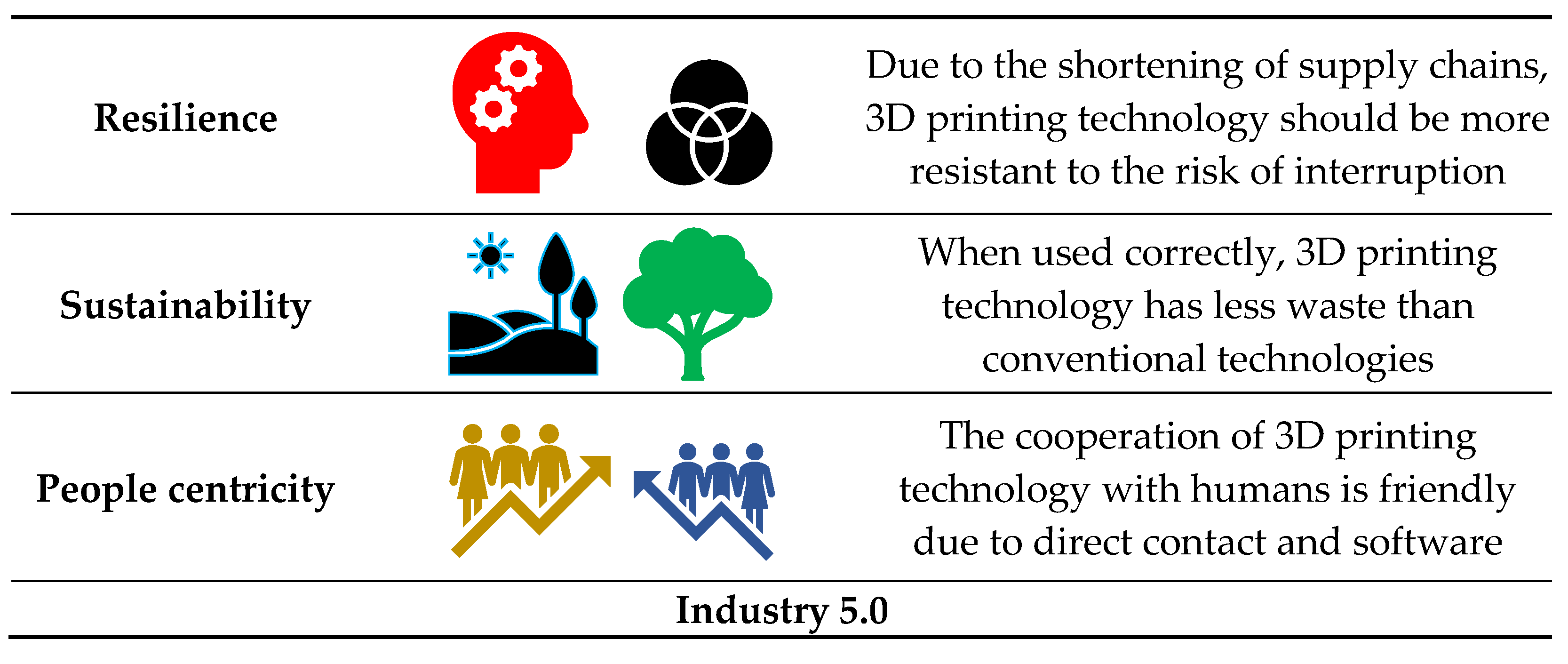
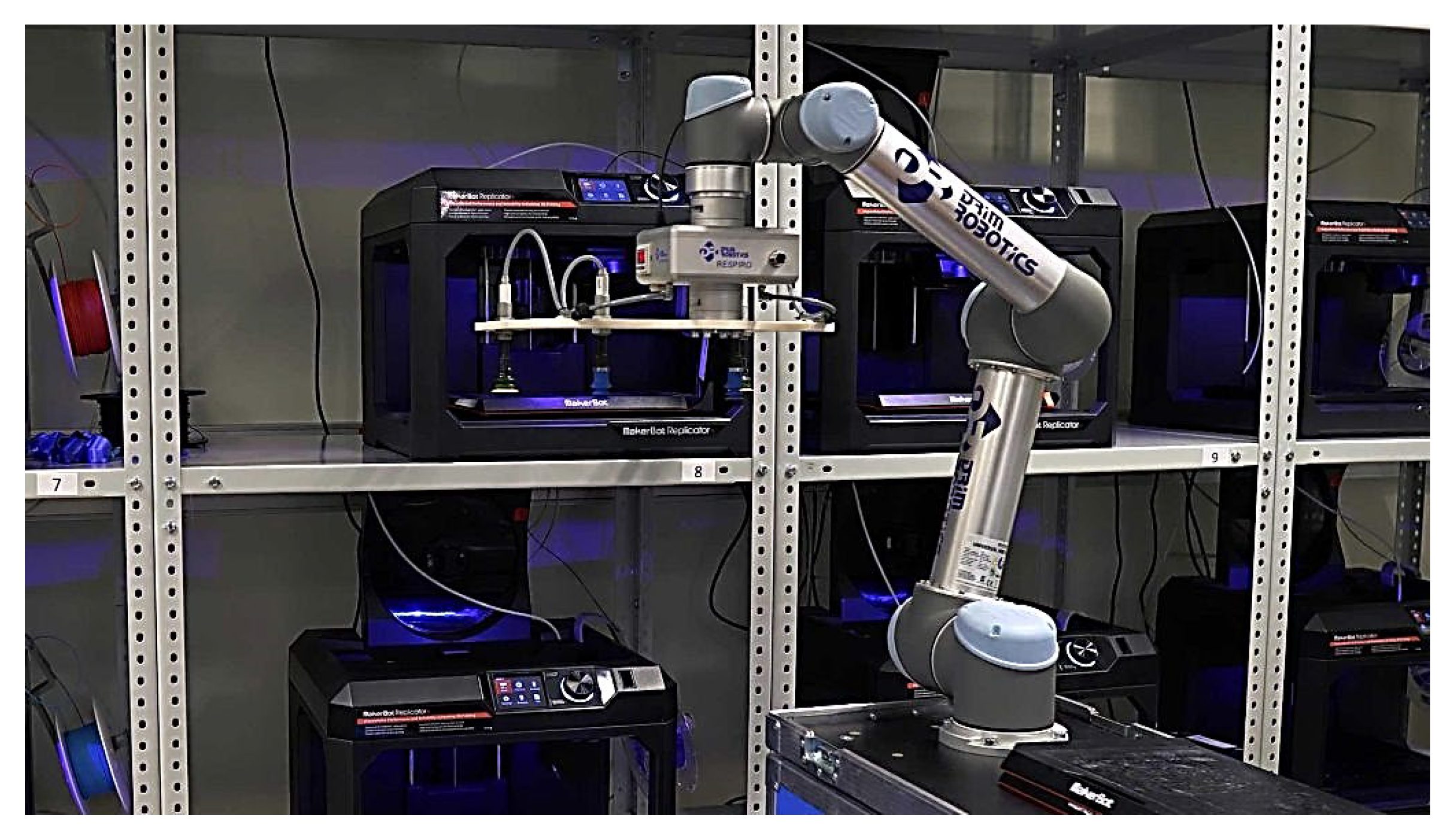
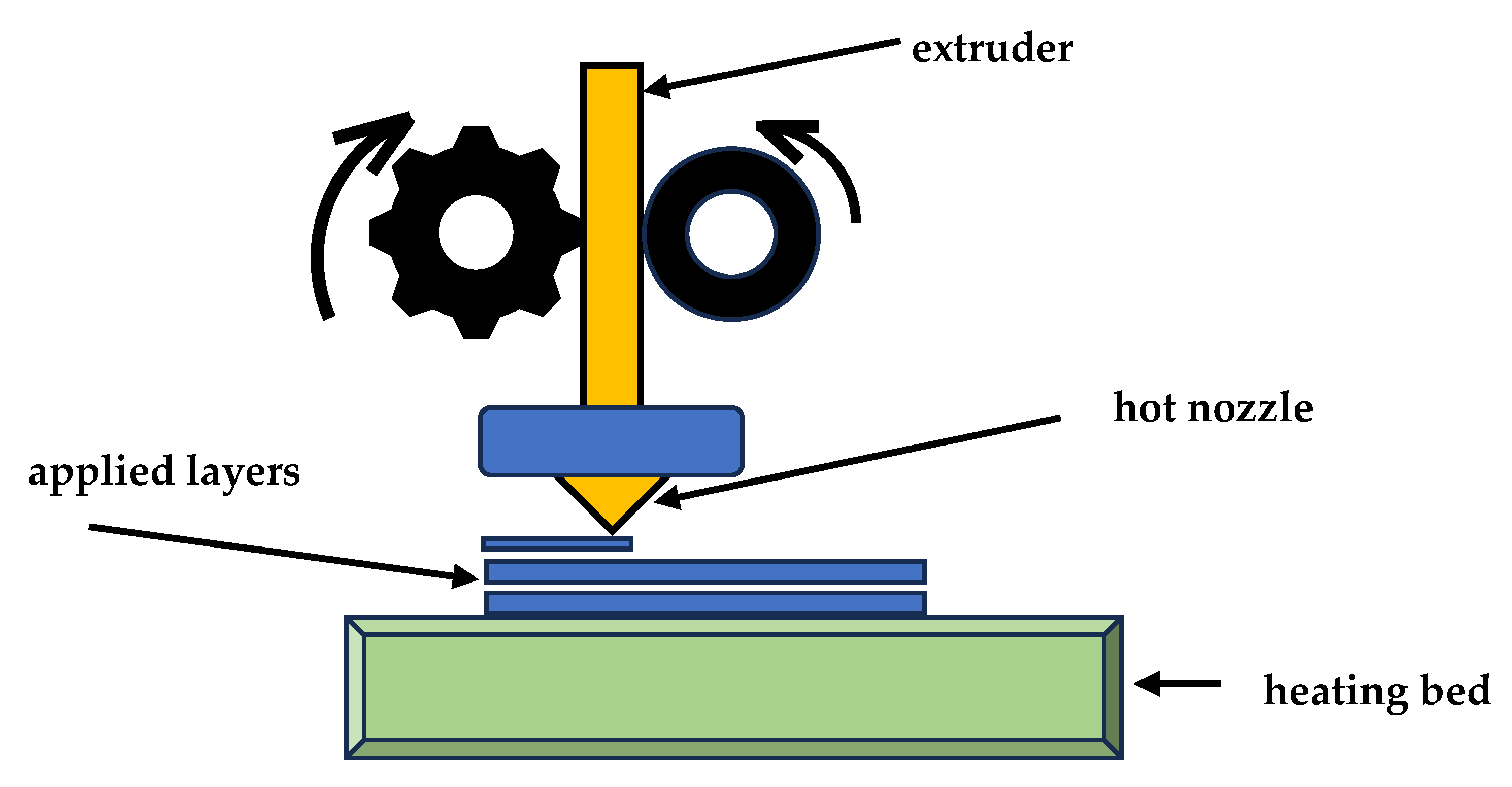
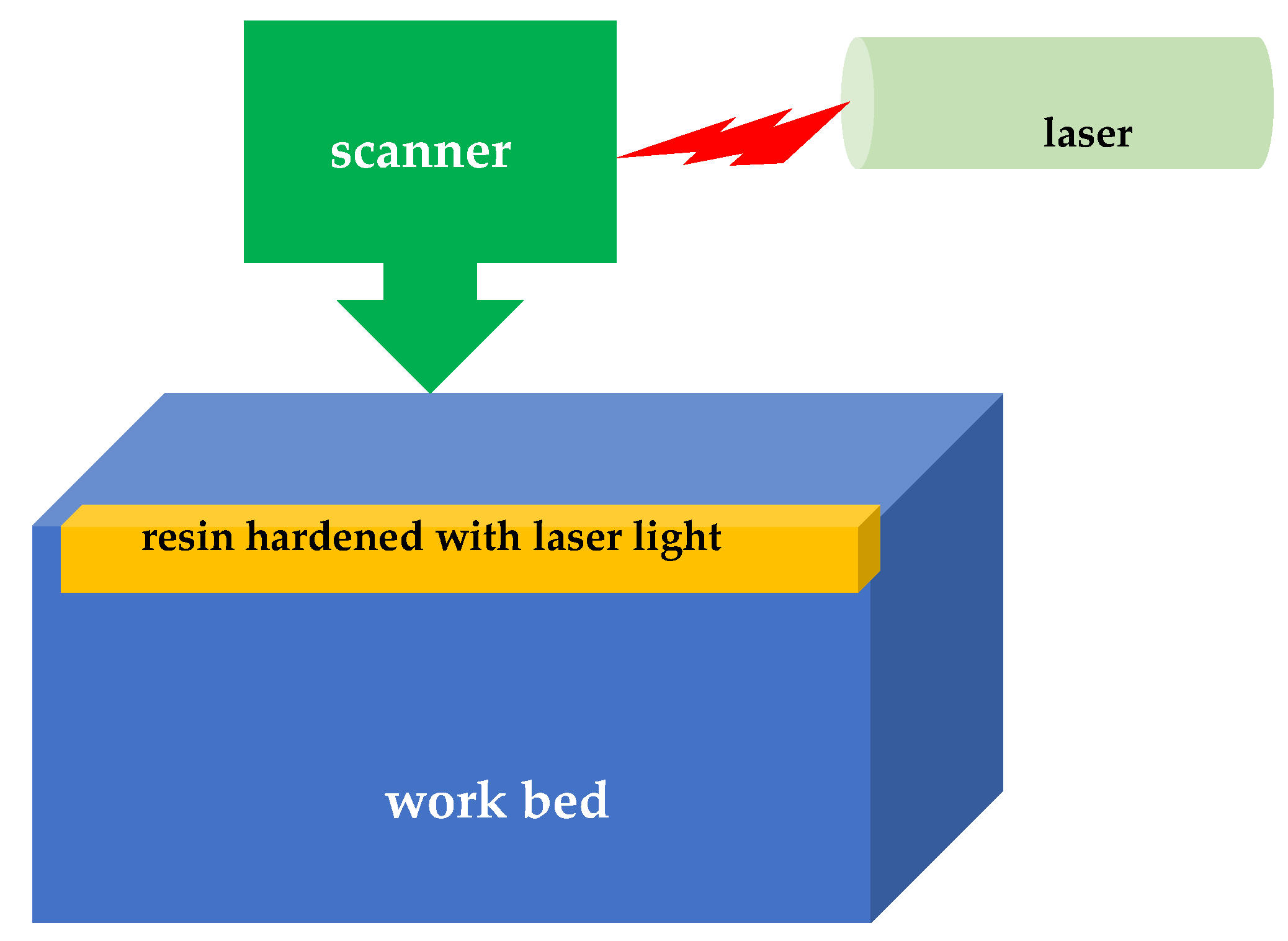

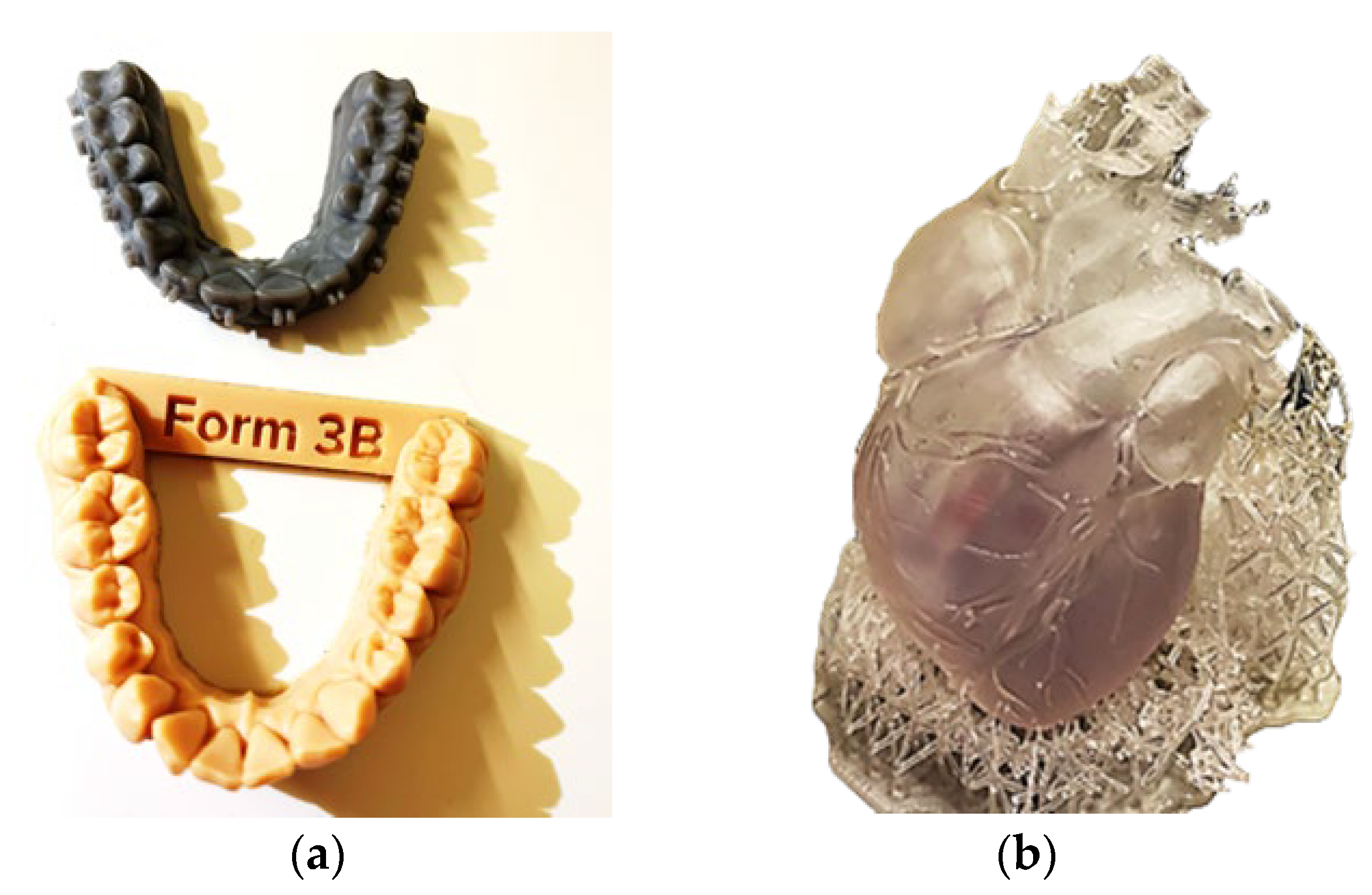
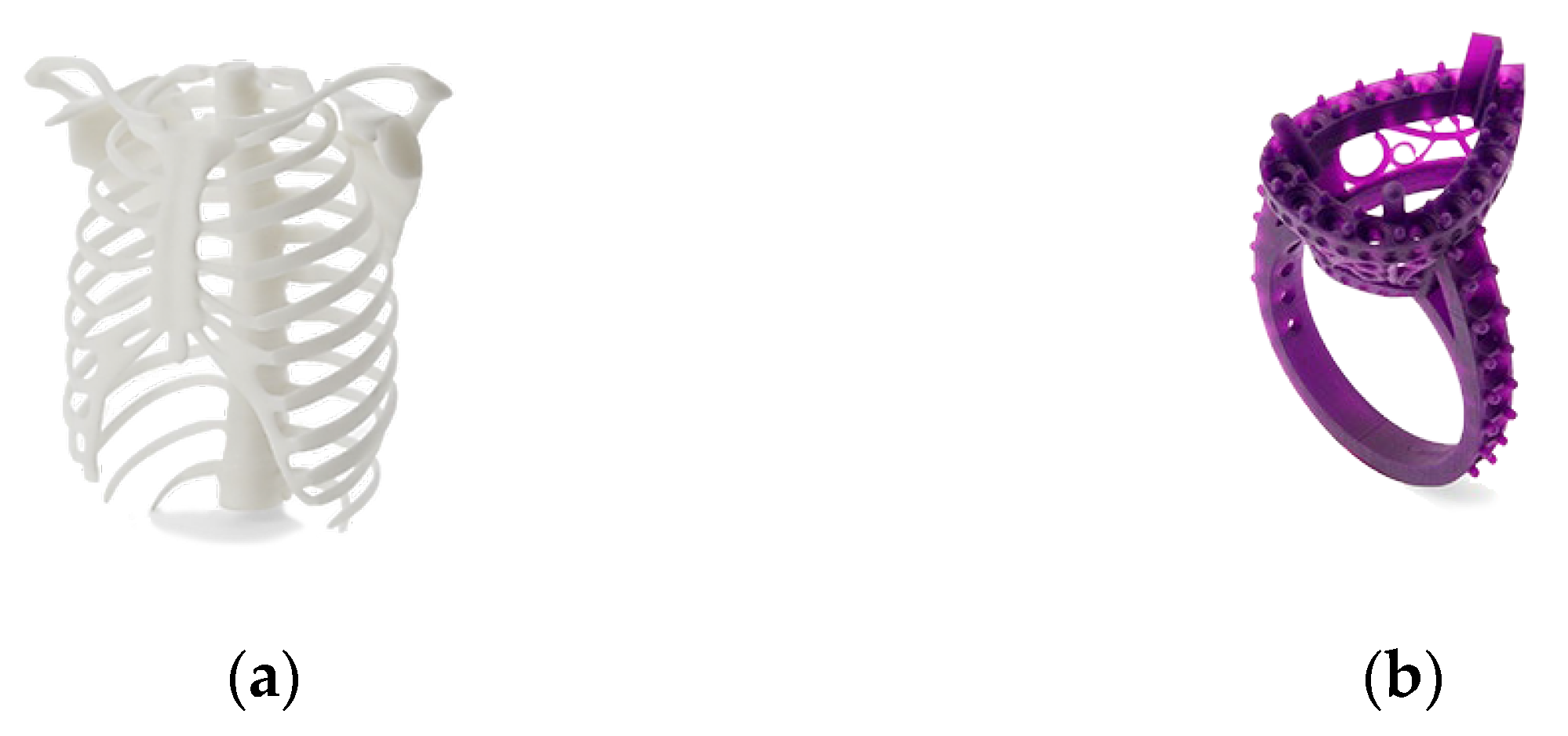
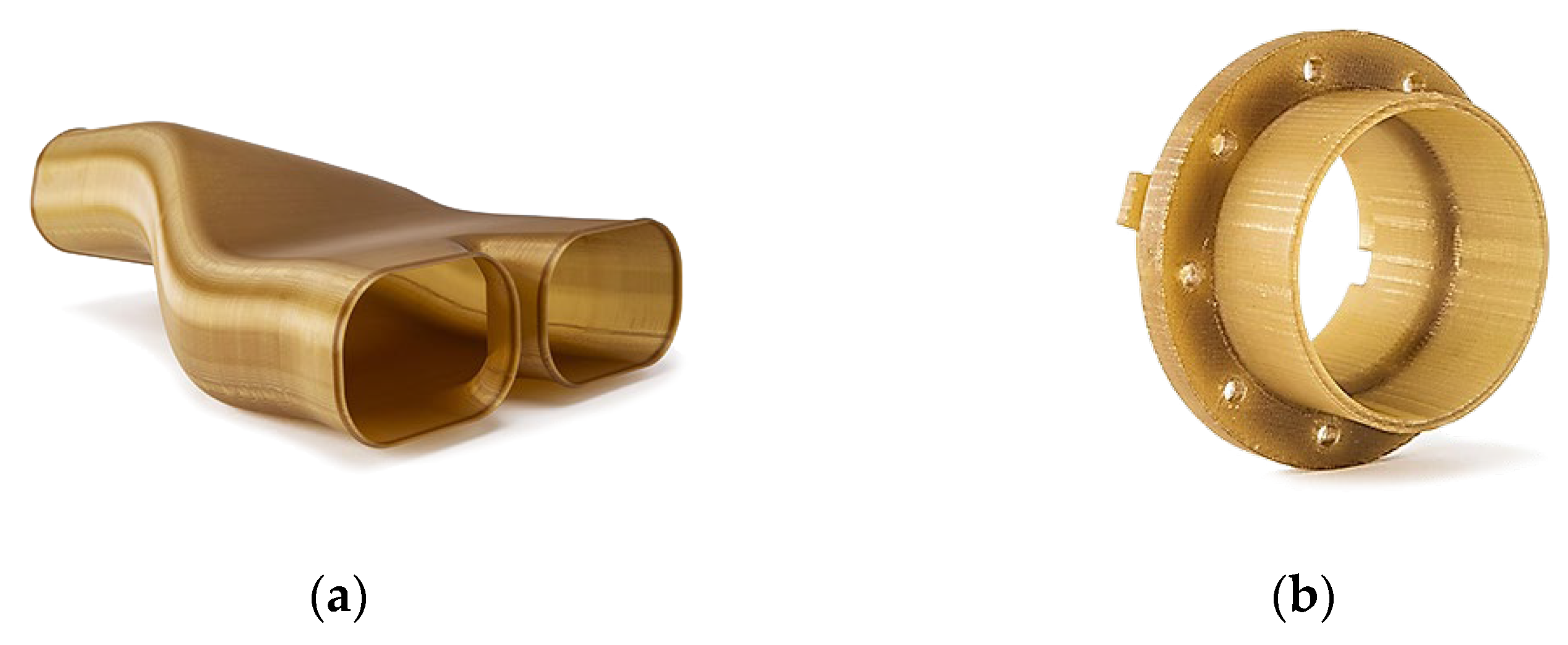
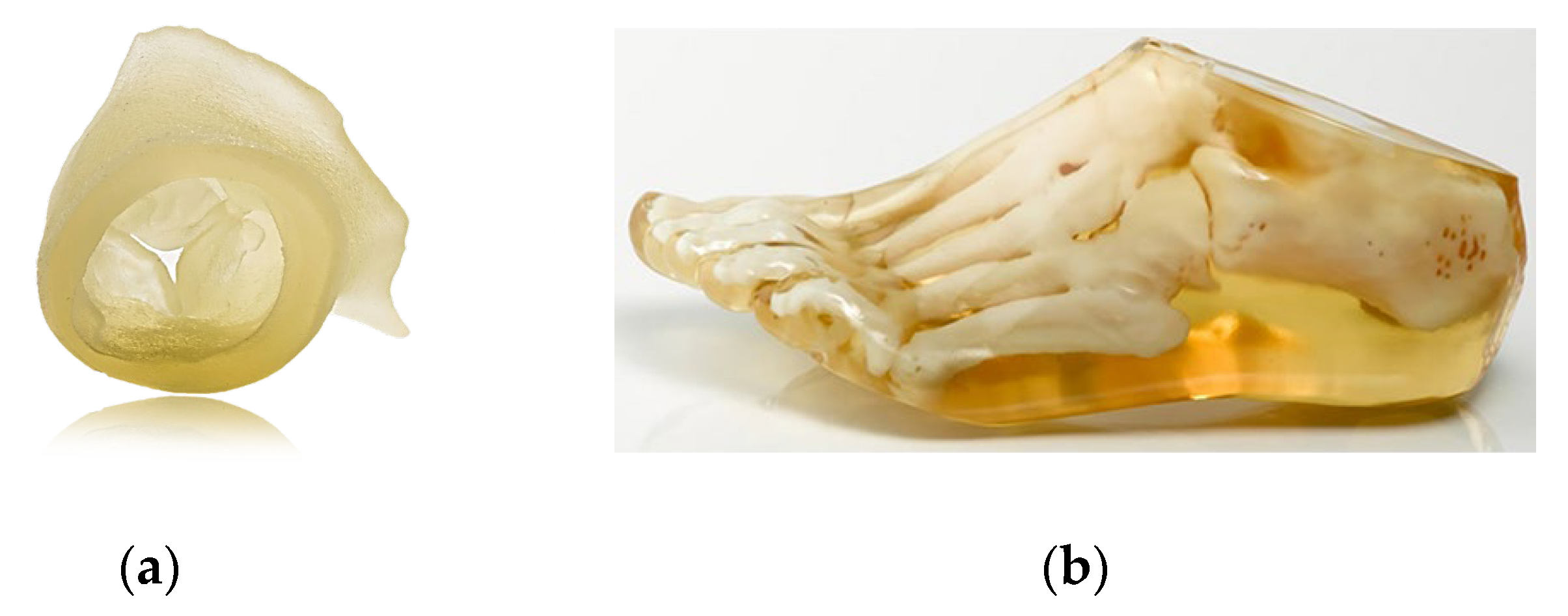
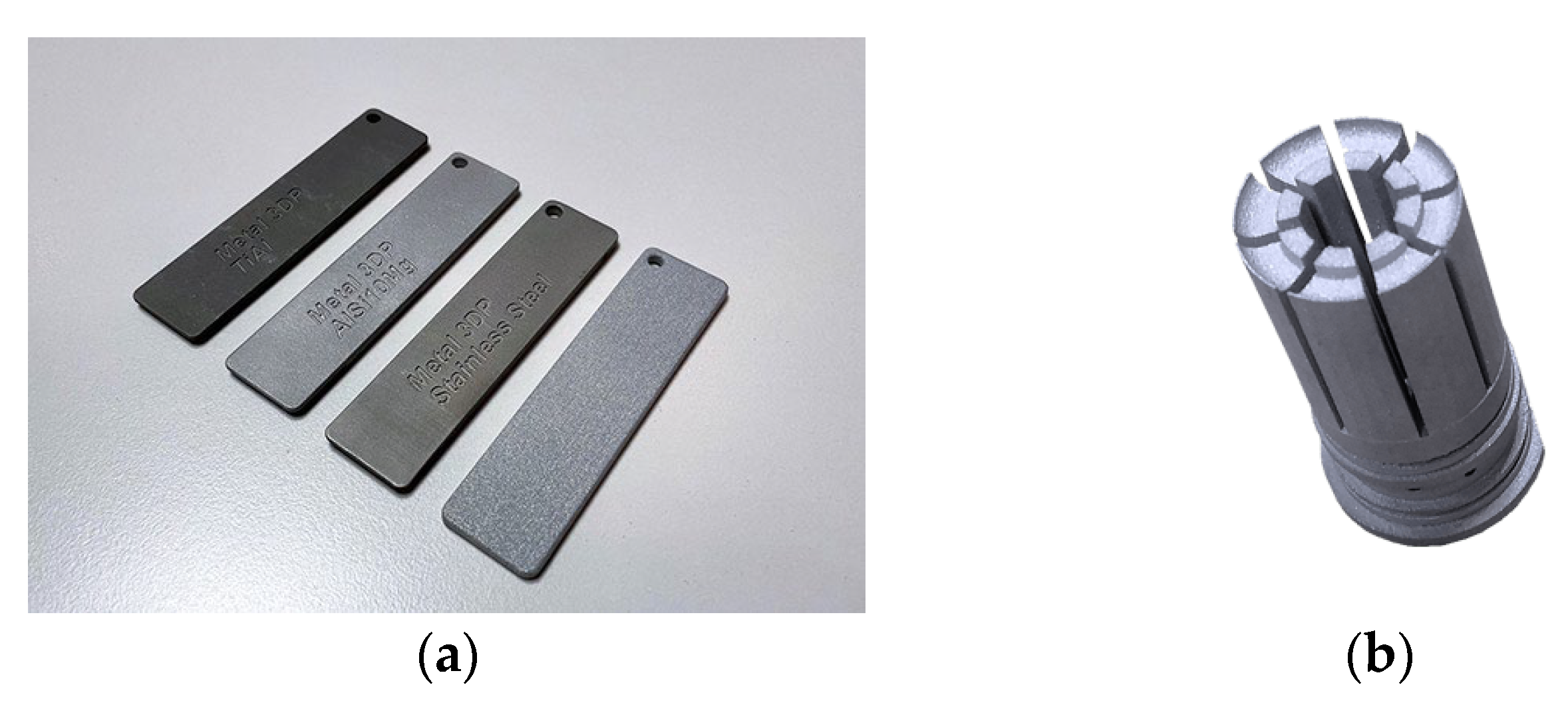
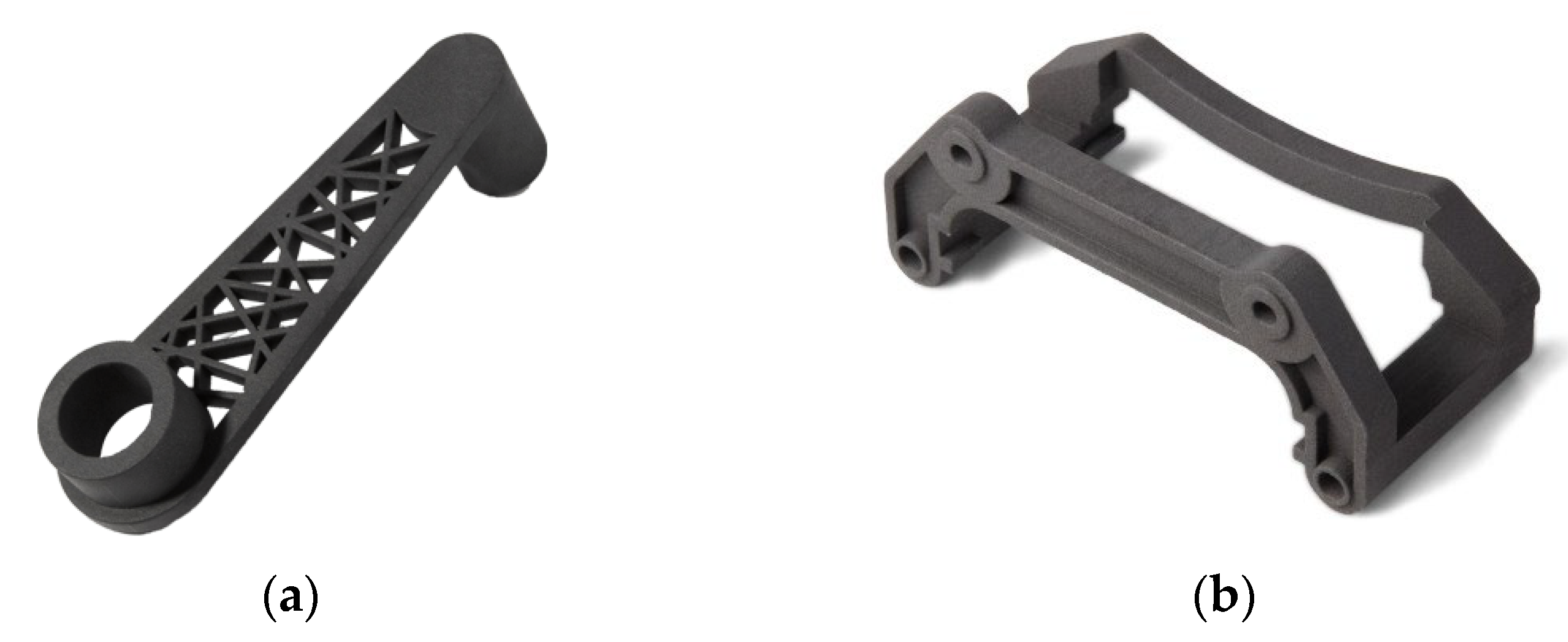
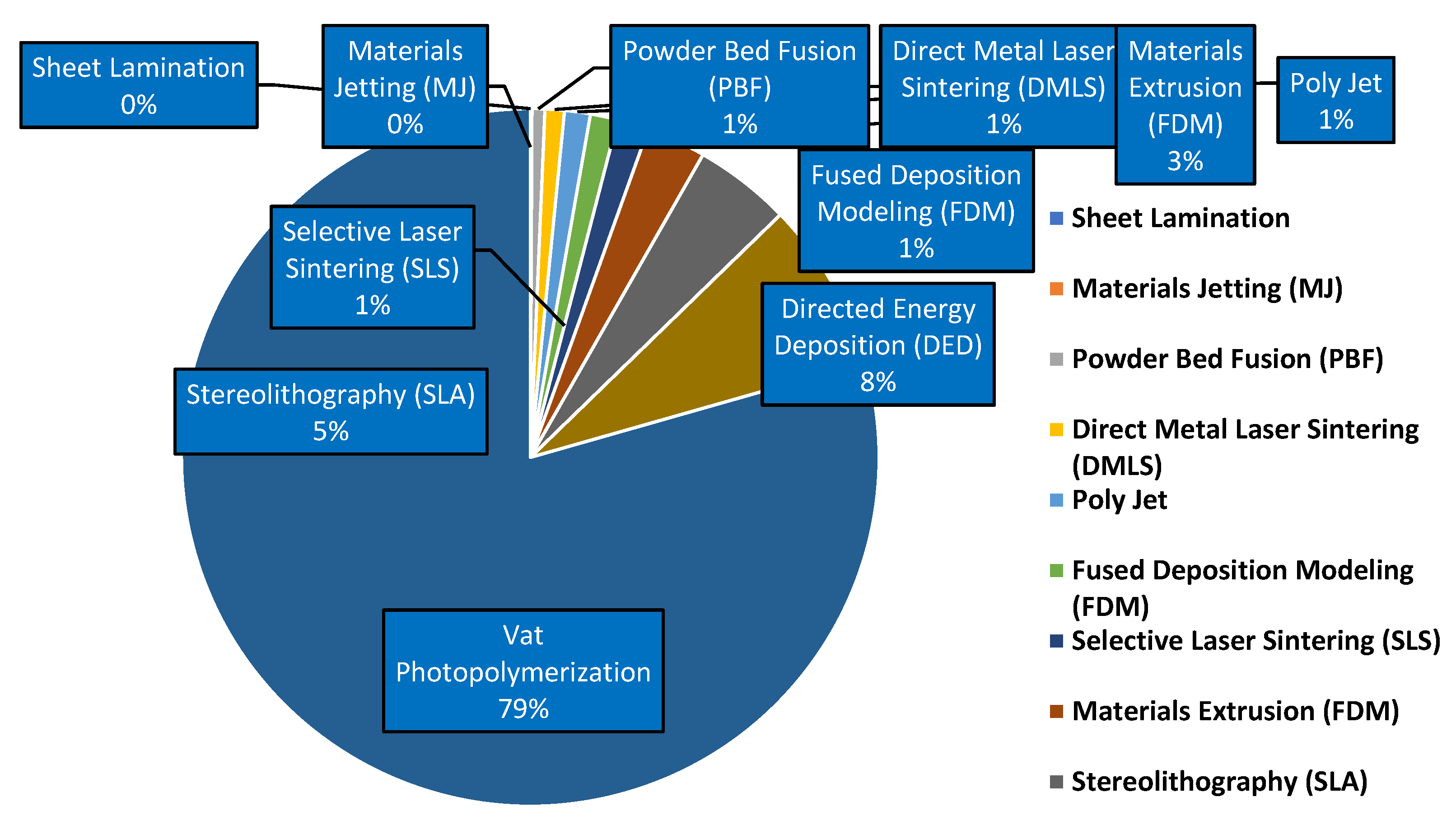
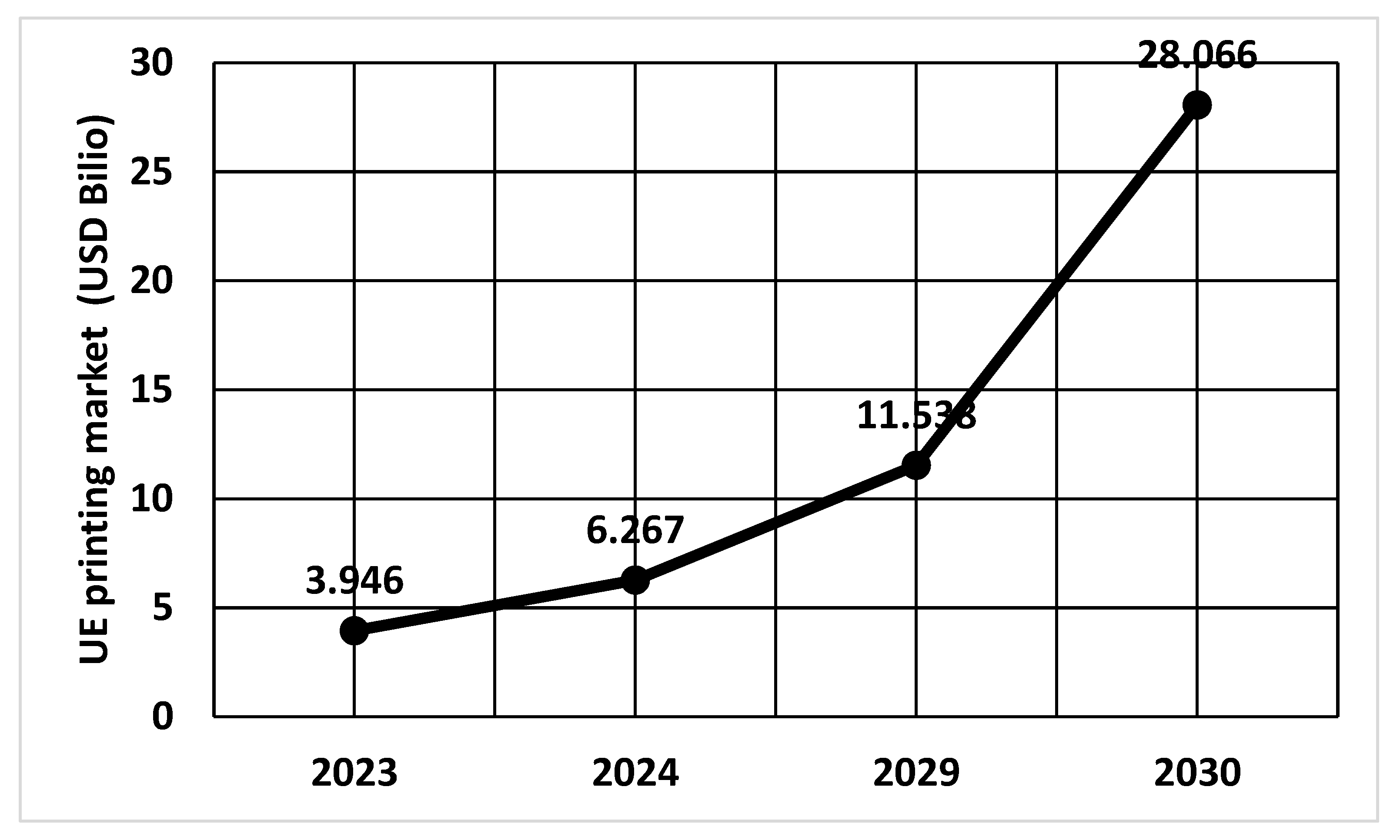

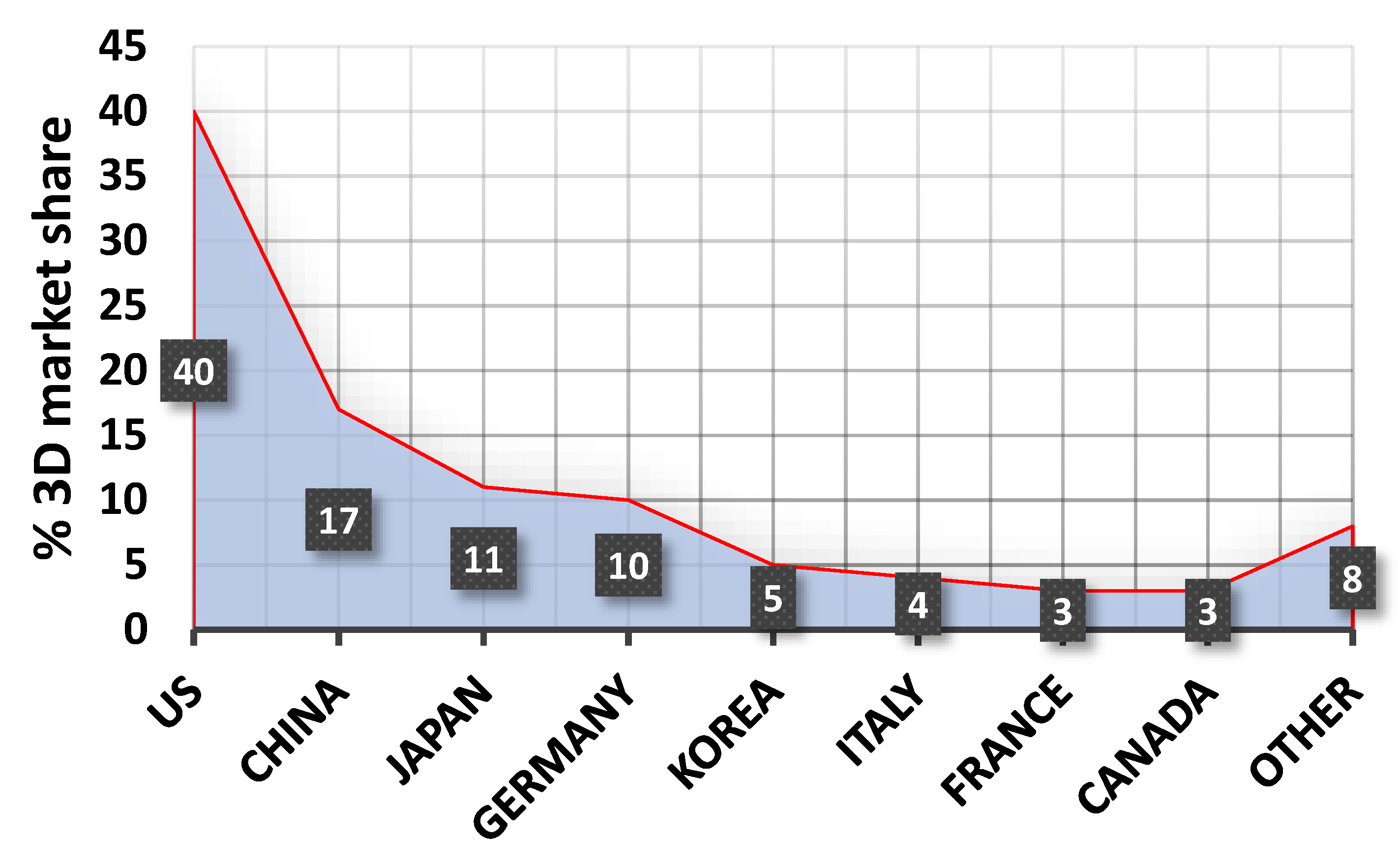
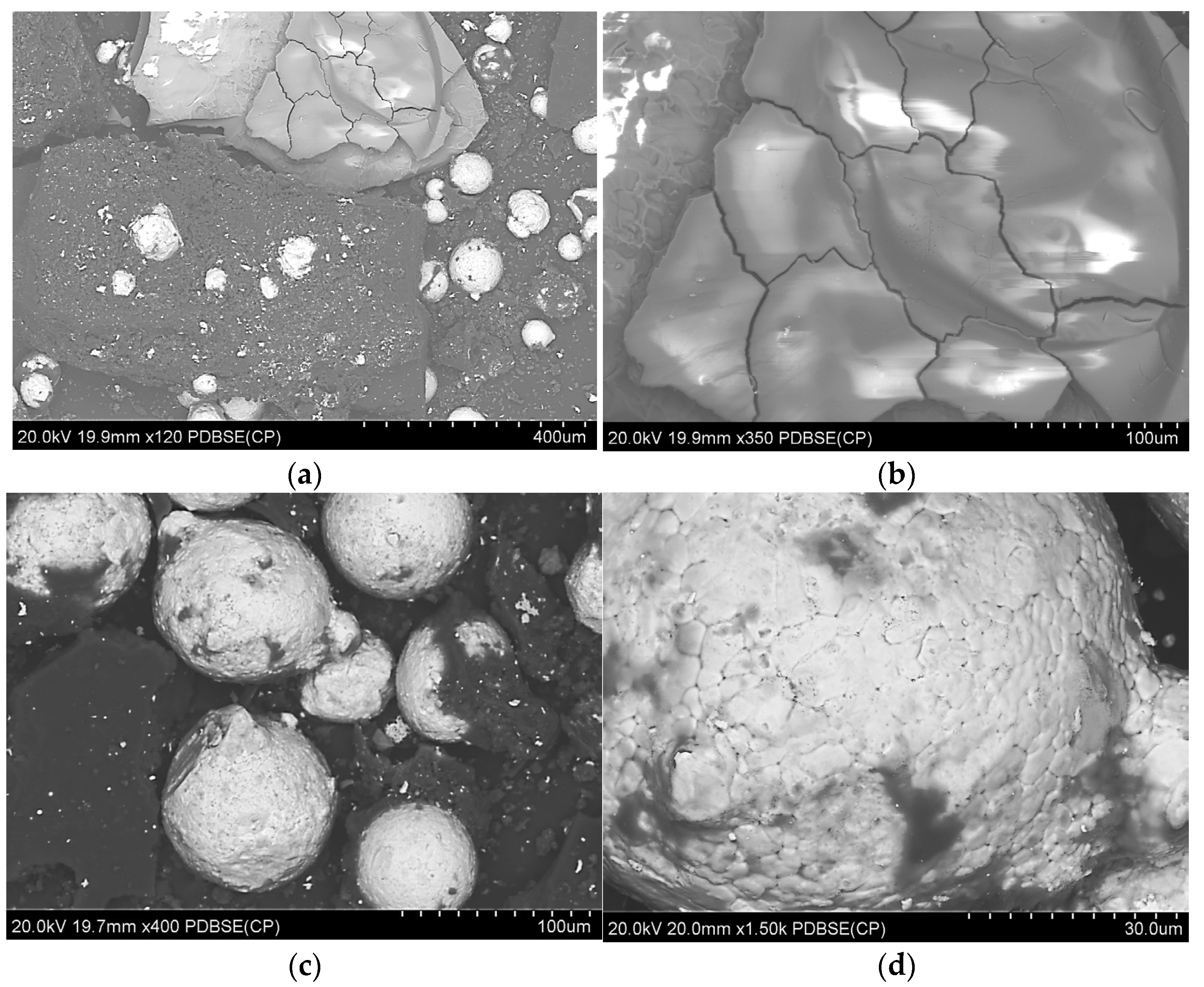
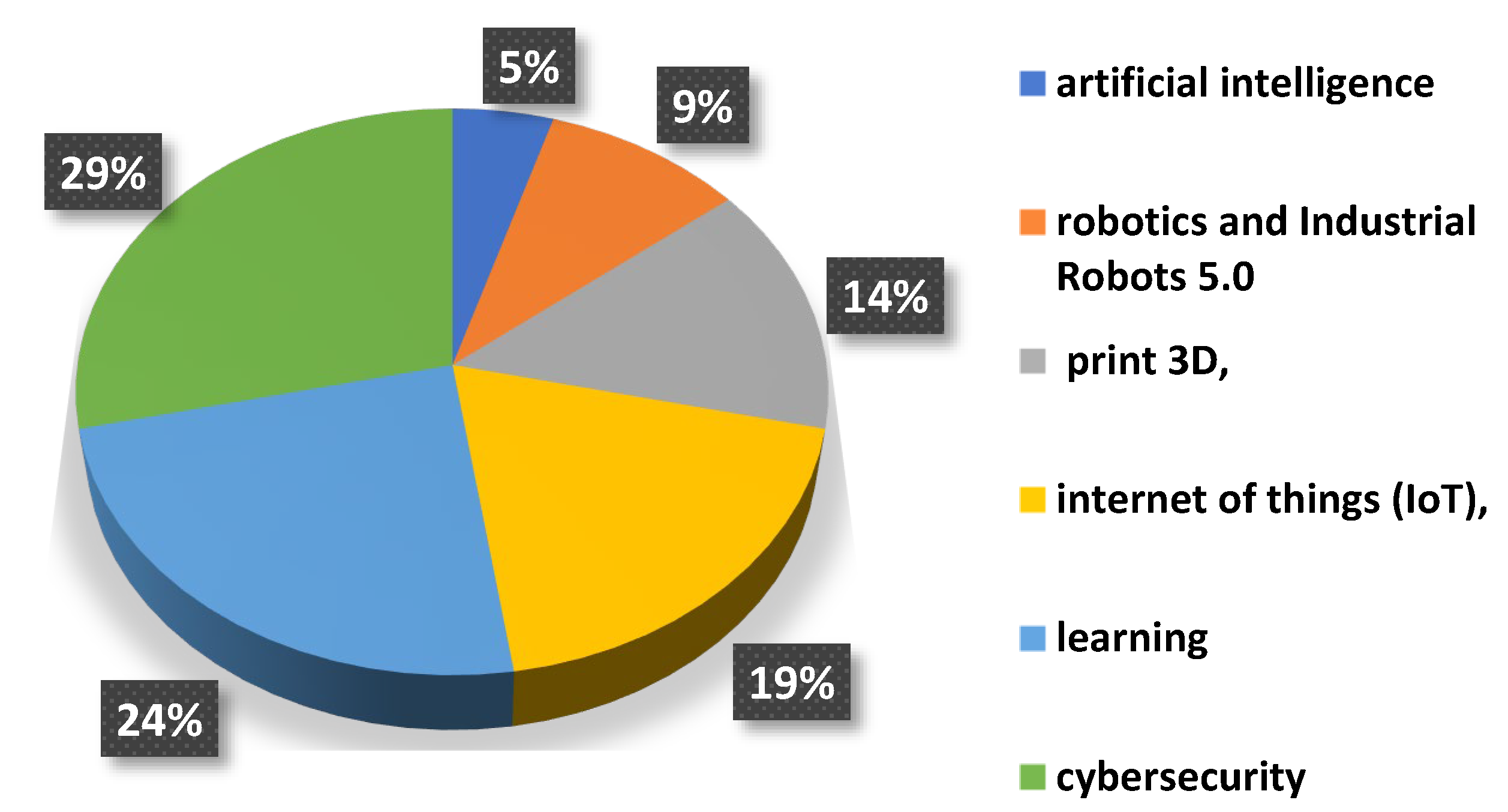
| Industry 4.0 | Industry 5.0 |
|---|---|
| implementation of automatic devices and digital solutions | implementation of automatic devices and digital solutions |
| linking the operation of machines with IT systems | combining work performed by people and machines so that they complement each other |
| automation and digitization of industrial processes | cooperation between people and machines, making complex decisions |
| using data to make decisions and increase efficiency | more flexible and personalized production process |
| focus on digitization and connection of industrial production systems using advanced technologies such as the Internet of Things or cloud computing | focusing on cooperation between people and robots, combining human abilities and knowledge with the efficiency and precision of machines |
| technological tasks are performed by machines, processes are automated | strengthening the role of employees in the production process |
| emphasizes mass customization and flexible production, which allows products to be tailored to customer needs | promoting highly personalized production to order; articles are produced in a very individualized way, in accordance with the customer’s preferences |
| technologies such as the Internet of Things, big data, artificial intelligence, virtual reality, and cloud computing dominate; their task is to automate processes, analyze large amounts of data, and support predictive decision-making | in addition to technology, there are advances in collaborative robots (cobots), exoskeletons, augmented reality, and advanced artificial intelligence systems that enable close interaction between humans and machines |
| striving to increase efficiency and reduce energy consumption using automation and cutting-edge technologies | places greater emphasis on the use of renewable energy sources and the design of energy-efficient systems to achieve a more sustainable production process and reduce the carbon footprint |
| Main 3D Printing Technology | Varieties of Technology | Process Characterization |
|---|---|---|
| Vat photopolymerization Vat photopolymerization uses a vat of liquid photopolymer resin from which the model is built layer-by-layer. Ultraviolet (UV) light is used to harden the resin when required, while the platform moves the object being created downwards after each new layer has cured. | Stereolithography (SLA) | Laser to trace each layer individually. |
| Digital Light Processing (DLP) | Irradiates each layer all at once using a projector, resulting in faster print times. | |
| Liquid Crystal Display (LCD) | Uses an LCD mask to control light exposure, potentially allowing for larger build volumes. | |
| Continuous Liquid Interface Production (CLIP) | Compared to SLA, DLP significantly reduces printing time by solidifying an entire layer at once. | |
| PolyJet | Print heads spray successive layers of liquid light-curing photopolymer onto the build platform, which then hardens under the influence of ultraviolet (UV) light. | |
| Computed Axial Lithography, CAL | This process allows you to create the desired 3D structure in one printing step. | |
| Directed Energy Deposition (DED) It is a 3D printing method which uses a focused energy source, such as a plasma arc, laser, or electron beam to melt a material which is simultaneously deposited by a nozzle. Most frequently used for metals in powder or as a wire. | Laser Metal Deposition (LMD) | A laser is used as an energy source to melt metal powders. |
| Cold Spray (CS) | CS produces parts with a very high density, >99%, due to the very high velocity imposed on the particles. | |
| Power Bed Fusion (PBF) Any powder-based materials can be used in PBF technology. Thermal energy is used to selectively combine the powder, which in various versions of PBF technology is obtained from various sources. It may be a laser pulse, an electron beam, or a heated print head. The material granules can be sintered or fused, depending on the heat intensity level. | Laser Powder Bed Fusion (SLM) | Laser heat is used to fuse metallic powders. |
| Electron Beam Melting (EBM) | Melting with an electron beam. | |
| Selective Laser Sintering (SLS) | Selective hot sintering. | |
| Direct Metal Laser Melting (DMLM) | Direct laser melting of metals. | |
| Directed Metal Laser Sintering (DMLS) | Directed laser sintering of metals. | |
| Material Extrusion (FDM) In this technology, the material is extruded through a heated nozzle. The process involves extruding a plastic thread in accordance with a computer-defined program for shaping a three-dimensional object. The dimensional accuracy of the process is: ±0.5% (lower limit ±0.5 mm). | Fused Deposition Modeling (FDM) | It is an extrusion-based method where filament, produced by hot-melt extrusion (HME), is heated within the head of the printer cartridge and extruded through a nozzle onto a build platform. |
| Direct Ink Writing (DIW) | Direct Ink Writing (DIW) is an extrusion-based additive manufacturing method heavily utilized in meso- and micro-scales. | |
| Binder Jetting (BJ) The print head selectively sprays a liquid bonding agent onto a thin layer of building material, layer-by-layer, according to the prepared bitmap. After the printing process, the manufactured products are sintered in a high-temperature furnace. | The process involves applying layers of metal or ceramic powder to the surface of the worktable. Then, a special, numerically controlled print head applies a liquid binder, creating three-dimensional units called voxels. During heating and sintering, the binder, usually based on photo polymers, evaporates in the later stages of the process. | |
| Material Jetting (MJ) In the spraying process, molten material droplets are deposited on the 3D printer’s working platform and then hardened with ultraviolet light or heat. In this way, three-dimensional objects are formed layer-by-layer. | Poly Jet | It uses liquid photopolymer resins hardened layer-by-layer with UV light. Piezoel-electric heads apply a layer of liquid material to the work table, and then each layer is automatically exposed to a UV light head. After hardening, another layer of resin is applied. |
| NanoParticle Jetting (NPJ) | Compared to other technologies, it offers accuracy, high resolution and design freedom thanks to the easily soluble support material. NanoParticle Jetting produces parts by ejecting thousands of nanoparticles from ink nozzles in ultra-thin layers. The deposited nanoparticles vary in size and shape and are randomly distributed on the working platform, creating highly packed structures. | |
| Drop-On-Demand (DOD) | Drop on Demand (DOD) involves placing molten drops of material onto the surface until a finished object is obtained. | |
| Sheet Lamination (SL) The sheet lamination (SL) manufacturing technique, also known as laminated object manufacturing (LOM), consists of superpositioning several layers of material composed of foil to manufacture an object. These sheets of material are glued together layer-by-layer and cut into shape using a knife or with laser cutting. | Matt Lamination | Matte laminate has a “natural” appearance with lower contrast than other products, which ensures a velvety texture of the products. |
| Glossy Lamination | The product is shiny, resistant to dirt, dust and fingerprints. | |
| Velvet Lamination | Velvet lamination involves coating plain paper with a layer of plastic. As a result, the product has a softer outer surface and higher quality. |
| Technology 3D | Advantages | Disadvantages | Materials and Applications |
|---|---|---|---|
| Vat photopolymerization [60] | Ability to produce final details with high dimensional accuracy, the smoothest finish surface, and dimensional tolerances are below 0.05 mm. Finished models can be painted, moderately fast. Economical for producing small quantities of parts. | The method requires the use of supports, materials for production are expensive, the processing of products is long and complicated, the resin is toxic, and its mixing with IPA makes it even more dangerous, the liquid must be secured and sent for disposal to a specialized company, the waste is not suitable for recycling and is difficult to manage, prints are weakest in the vertical direction of the structure due to the anisotropy of the material properties and due to the additive layer method, the laser must be calibrated periodically, the thickness of the layers may be different for different resins, the work table is covered with a layer of uncured resin that must be removed, which affects the costs and extends the production time of the detail. | Materials: main components of photopolymerization prepolymers or oligomers, monomers, and photo initiators. Oligomers such as acrylates and epoxy resins are the main components of the photopolymer, which determine the physical properties of the SLA product, synthetic hydrogel monomers are polyethylene glycol (PEG), polyacrylic acid, polylactic acid, polyglycolic acid, or poly (lactic-co-glycolic acid). Bio resins composed of natural and synthetic polymers, such as polyethylene glycol-conjugated chitosan and the combination of alginate with methacrylate gelatin (GelMA), are also popular choices for VP-based bioprinting. The bio resins employed in VP-based bioprinting are primarily composed of solvent water, photoactive monomers or oligomers, and PI. Applications: Medicine and dentistry production of implants and various prototypes; photopolymerization is successfully used in medical modeling, which allows the creation of accurate 3D models of various anatomical areas of the patient based on data from computer scans. Vat photopolymerization is also particularly suitable for the production of small components made of technical ceramics. |
| Direct Energy Deposition (DED) [61] | Possibility to create very large elements, high production speed, creation of high-density details, possibility to repair damaged details, possibility to apply coatings resistant to abrasion, corrosion, etc., adding metal elements to existing parts, producing details from several materials in one process. | Parts require heat treatment to remove residual stresses, residual stresses may lead to deformation and damage to printed elements, low surface quality, and complicated internal channels are an additional challenge. | Materials: Spherical metal powder with a gradation of 45–150 µm or wire with a diameter of 1 to 3 mm is used, typically used to work on metal parts; this process can also be used with polymers and ceramics, almost any weldable metal can be additively manufactured using DED, including aluminum, Inconel, niobium, tantalum, titanium, and titanium alloys, tungsten, stainless steel 316L, 304, 15-5PH, 17-4PH, steels H13 and 1.2709; nickel alloys—Inconel 625, Inconel 718, Hastealloy X, Waspalloy; stopy tytanu: Ti6Al4V ELI; cobalt alloys: Stellite 6, Stellite 12, Stellite 21. Applications: DED can be used to fabricate parts but is generally used for repair or to add material to existing components, and applications for DED fall into three categories; near-net-shape parts, feature additions, and repair. |
| Power Bed Fusion (PBF) [62] | Production of elements with complicated and complex geometry, maintaining high strength parameters of parts while reducing their weight. Easy removal of unbaked powder. High quality of the surface of printed elements. Possibility of producing elements with fine details, high density details, and construction of cooling channels with a complicated course. | After the printing process, the parts require heat treatment to remove residual stresses, which may lead to deformation and damage to the printed elements, complicated repair of damaged parts, necessity to use support structures. | Materials: Common metals and polymers, metal powders with precisely defined morphology, and particle size-aluminum alloys, nickel alloys, stainless steels, titanium, cobalt and copper alloys, polymers such as SHS, nylon DMLS, SLS, and SLM: Applications: Medicine: L-PBF enables the creation of implants, prostheses, surgical tools, and other highly precise medical components. Automotive: L-PBF 3D printing is used to produce custom automotive parts, exhaust systems, turbochargers, and other components. It is one of the most popular 3D printing techniques used in industrial additive manufacturing (AM). |
| Binder Jetting (BJT/BJ3DP) [63] | Low costs, high repeatability of prints, allows create large prints; parts do not have residual stresses, very high printing speed; does not require the use of supporting structures; in the printing process, no heat source is used to combine the metal powder. No build platform is required; economically viable. | Dimensional instability of printed objects, parts require an additional sintering process or infiltration in the furnace to improve their mechanical properties, high porosity of prints even after the sintering process, shrinkage of parts, porosity reduces the strength properties of prints. | Materials: Sand and metal powders, ceramics, metals (316L stainless steel, Inconel 625, titanium 6Al-4V, aluminum (various alloys), copper, tool steel, maraging steel, cobalt chrome, nickel alloys, precious metals, and various plastics. Applications: For the production of full-color prototypes, low-cost metal parts, the production of large cores and sandblasting casting molds, aerospace components, chemical processing equipment, turbine blades, heat exchangers, rocket engine components, aerospace components, medical implants, sporting goods, car parts, radiators, electronic housings, heat exchangers, electrical components, radiators, cutting tools, dies, molds, aerospace components, defense applications, joint replacement, dental implants, coprocessing equipment, oil and gas components, jewelry, electronic components, and medical devices (limited applications). |
| Material Extrusion (FDM [64]) | The cost of printing compared to other technologies is relatively low, availability of various materials, ease of subsequent processing of the product, possibility of changing the material during printing to another one, short prototyping time. | Lower print accuracy compared to other technologies, during complex prints it is difficult to remove the support material, lower durability compared to other technologies, print layers are often very visible to the human eye. | Materials: thermoplastic polymers. Materials used in FDM processing include polycaprolactone (PCL), polypropylene (PP), polyethylene (PE), polybutylene terephthalate (PBT), acrylonitrile butadiene styrene (ABS), wood, nylon, metals, carbon fiber, graphene-doped PLA, etc. Polymer nanocomposites, hydrogels, alloys and pure metals with melting points up to 700 degrees Celsius. The most common FDM 3D printing materials are PLA, ABS, PET, nylon, TPU (Flexible), PC and their various blends. Applications: FDM is used in aerospace and automotive industries. Fused deposition modeling or FDM is the most popular method of 3D printing for pharmaceuticals. |
| Material Jetting (MJ) [65] | It is one of the fastest as well as one of the most accurate 3D printing technologies, developed different types of material jetting for different applications, integrating multiple material parts and colors in one single printing, and can be used for a combination of multiple materials. | Requires supports. After printing, support materials are dissolved or removed manually, leaving behind a clean, smooth object. The printing materials must have the right flow properties to ensure precision without compromising strength, the environment and machine need to maintain optimal temperature conditions to avoid material expansion or contraction. It can be more expensive compared to other 3D printing techniques. | Materials: The most commonly used are PLA, ABS, and PET-G. Applications: It is used by a multitude of industries such as automakers, design firms, art studios, or medical organizations to create reliable prototypes with a high level of accuracy. NanoParticle Jetting (NPJ) is the best option when you need to manufacture multiple small parts at once. Drop-On Demand (DOD) is the preferred choice of the jewelry industry. Material jetting is a printing process with a high level of accuracy, which makes it popular for highly realistic prototypes, injection molds, investment castings, and medical devices. |
| Laminating Sheets or Laminated Object Manufacturing (LOM) [66] | Relatively economical in terms of material costs, the process is usually fast and effective, high precision of workmanship, the cheapest operation due to the lowest costs of obtaining appropriate paper, high accuracy, and very fast printing process, relatively low prices of materials for creating models. | The product requires cleaning and a large amount of waste that cannot be reused. | Materials: A variety of materials, metals, adhesive-coated paper, polyester laminate, and plastic. Applications: Manufacturing industry, for creating prototypes, tools, structural elements, and spare parts. In the medical industry, for the production of anatomical models, creating prostheses, and implants. Art and design, architecture, and education, for business cards, brochures, paper bags, boxes, flyers, posters, books, roll-up banners, and other marketing and promotional materials. |
| Type of Material | 3D Printing Method |
|---|---|
| Metal printing | SLM (Selective Laser Melting) LPBF (Laser Powder Bed Fusion) DMLS (Direct Metal Laser Melting) FDM (Fused Deposition Modeling) SLS (Selective Laser Sintering) |
| Polymer printing | SLA (Stereolithography) DLP (Digital Light Processing) MJF (Multi Jet Fusion) FDM (Fused Deposition Modeling) |
| 3D Printing Technology | Technology Parameters |
|---|---|
| Vat Photopolymerization | Vertical build rate: up to 18 mm per hour (material and layer thickness dependent) Materials: Poly(ethylene glycol) diacrylate (PEGDA), Poly(ethylene glycol) dimethyacrylate (PEGDMA), other diacrylate or dimethyacrylate functionalized polymers, and ceramic suspensions., Speed DLP/SLA 20–36 mm/h average, maximum 720 mm/s, SLA 48 mm/s, maximum 60 mm/s. In systems using the radical cross-linking mechanism, difficulties include not only sensitivity to oxygen inhibition, but also relatively high polymerization shrinkage of about 20%; printing parameters (e.g., single layer thickness, exposure time) are selected individually for each operation: the layer height should not exceed 75% of the nozzle thickness, the average layer thickness can be 50–100 µm, and in operation, the layer thickness reached 306 μm. |
| Direct Energy Deposition (DED) | Electron beam DED has the highest rate of up to 9 kg/h (20 lbs/h). Laser- and powder-based DED systems deposit material at the rate of 3 kg/h (6.5 lbs/h). Powder bed fusion systems have the lowest rate with deposition rates below 0.2 kg/h (0.44 lbs/h). The typical cooling rates are in the range of 102 to 104 K/s. Defined heating and cooling rates are important parameters for DSC measurements. International standards recommend a heating rate of 10 K/min or 20 K/min (ISO 11357, DIN 53765, ASTM E 793, ASTM E 794) when striving for thermodynamic equilibrium. Typical power values of our DED machines range between 5 and 20 kW, varying with material, deposition rate, and geometry. Typical layer thicknesses of 0.25 mm to 0.5 mm are recommended. The cooling times for materials are very fast, at around 1000–5000 °C per second. |
| Power Bed Fusion (PBF) | The power of the lasers used are 200–500 watts and the electron-beams are 1000–6000 watts. The particle size required for L-PBF ranges between 15 and 60 microns; E-PBF uses larger particles, between 45 and 105 microns. The deposition rate of the powder-feed/-bed technology is extremely low, typically around 10 g/min, and typically, a 0.1mm thick material is spread over the build platform. The standard film thickness for a standard powder coating for optimum mechanicals is between 60 and 80 microns. A classical active layer can be thawed to a depth of approximately 2–8 cm, and the thickest AL reaches over 20 m. L-PBF systems print most materials at speeds of 10–50 cc/h, while E-PBF prints at 50–90 cc/h (highly material dependent). |
| Material Extrusion (ME) | Alloys are extruded at speeds between 12 and 65 mm/s; the rate depends on the capacity and power of the equipment employed. Print speeds generally fall between 100 and 150 mm/s. Typical layer thickness varies from 0.178 mm to 0.356 mm. For great detail and layer-to-layer bonding, the thickness of each layer is kept constant between 0.1 mm and 0.2 mm. |
| Binder Jetting (BJ) | A typical resolution is 35 μm. Minimum feature sizes as low as 0.1 mm can be printed. Binder jetting typically reaches a dimensional tolerance of ±0.5% of the outer dimension and at best ±50 μm. Binder jetting also allows for complex geometries, does not require support structures, and has a dimensional accuracy of ±0.2 mm. In binder jetting, the layer thickness typically varies between 15 and 300 μm. The selection of a layer thickness is based on the size distribution of the powder, which, in turn, defines the resolution of the process along the build direction. Binder jetting also allows for complex geometries, does not require support structures, and has a dimensional accuracy of ±0.2 mm. The recommended minimum wall thickness for parts produced via binder jetting is 2.0 mm. |
| Material Jetting | Inkjet speed: 4000 drops of binder per nozzle per second. Build speed: up to ~200 cm3/min of parts. MJ technology supports dimensional tolerances in the range of ±300 µm (0.3 mm). A Hydro Jetting Machine is used for pressures ranging from 140 bar (2000 PSI) to 1400 bar (20,000 PSI). For material jetting, the typical layer height is 16–32 microns. Material jetting has a dimensional accuracy of ±0.1%. It has a typical lower limit of ±0.1 mm. |
| Sheet Lamination | The brow lamination process itself does not take very long, only around 15–20 min. It is recommended to adjust the temperature of the laminator as per below, given indicative temperature settings: 80 Microns −110 °C. 125 Microns −140 °C. 175 Microns −160 °C. It can take 24 to 48 h for the lamination and drying process. The laminate needs a minimum of 48 h to acclimate, but a full three days is best. The standard thickness for laminating pouches is 3 mil, 5 mil, 7 mil, and 10 mil. The thickness of the transformer core laminations is usually in the order of 0.25 mm to 0.5 mm. Laminate ranges from 6 mm to 12 mm and, as a rule, it should not be less than 8 mm. If, however, budget is an issue and if your subfloor is level and debris-free, you might be able to get away with 7 mm; the standard panel thickness is 10 mm, 13 mm, or 18 mm, with variants from 6 mm to 25 mm available for special applications. |
Disclaimer/Publisher’s Note: The statements, opinions and data contained in all publications are solely those of the individual author(s) and contributor(s) and not of MDPI and/or the editor(s). MDPI and/or the editor(s) disclaim responsibility for any injury to people or property resulting from any ideas, methods, instructions or products referred to in the content. |
© 2025 by the authors. Licensee MDPI, Basel, Switzerland. This article is an open access article distributed under the terms and conditions of the Creative Commons Attribution (CC BY) license (https://creativecommons.org/licenses/by/4.0/).
Share and Cite
Sala, D.; Richert, M. Perspectives of Additive Manufacturing in 5.0 Industry. Materials 2025, 18, 429. https://doi.org/10.3390/ma18020429
Sala D, Richert M. Perspectives of Additive Manufacturing in 5.0 Industry. Materials. 2025; 18(2):429. https://doi.org/10.3390/ma18020429
Chicago/Turabian StyleSala, Dariusz, and Maria Richert. 2025. "Perspectives of Additive Manufacturing in 5.0 Industry" Materials 18, no. 2: 429. https://doi.org/10.3390/ma18020429
APA StyleSala, D., & Richert, M. (2025). Perspectives of Additive Manufacturing in 5.0 Industry. Materials, 18(2), 429. https://doi.org/10.3390/ma18020429







